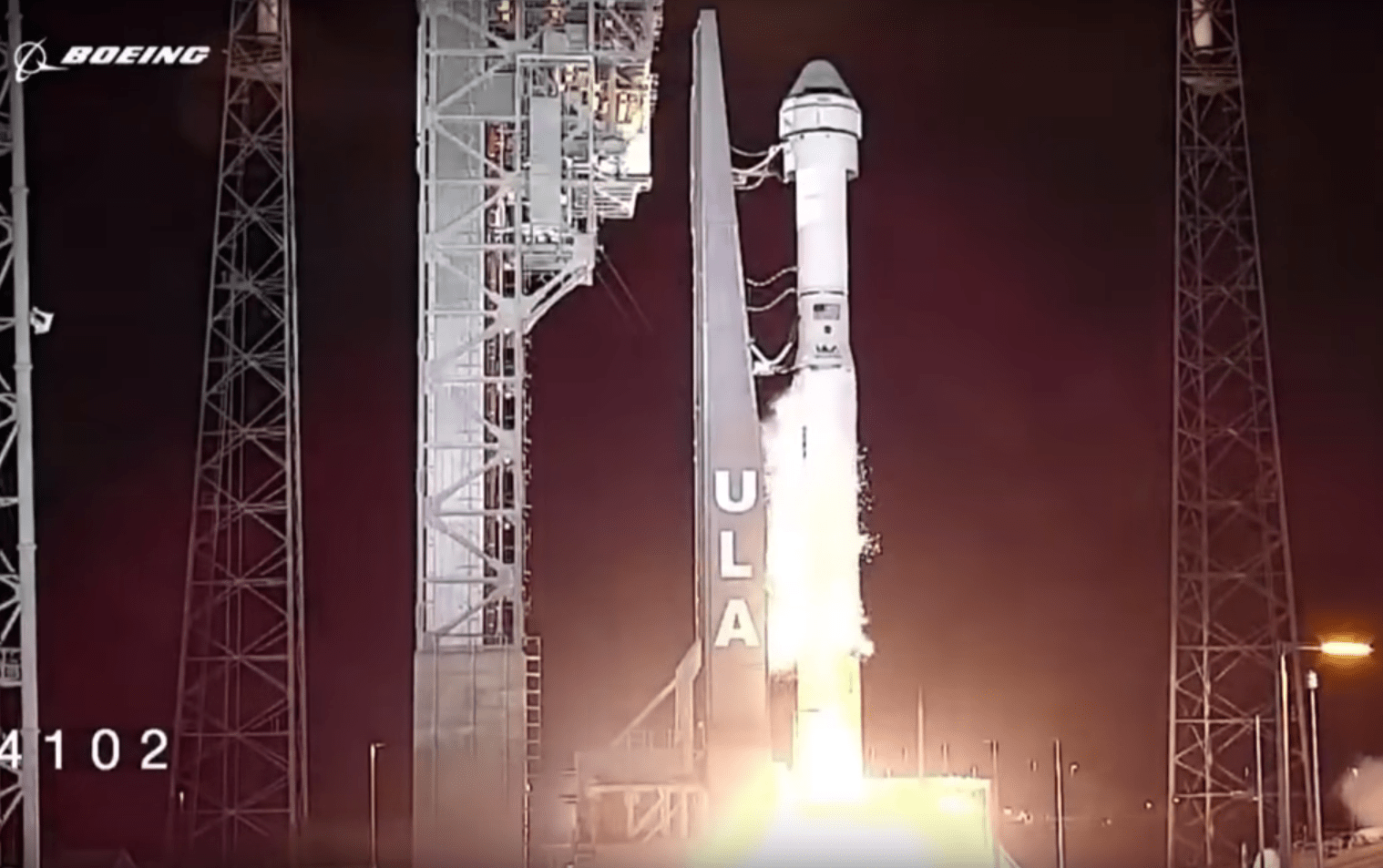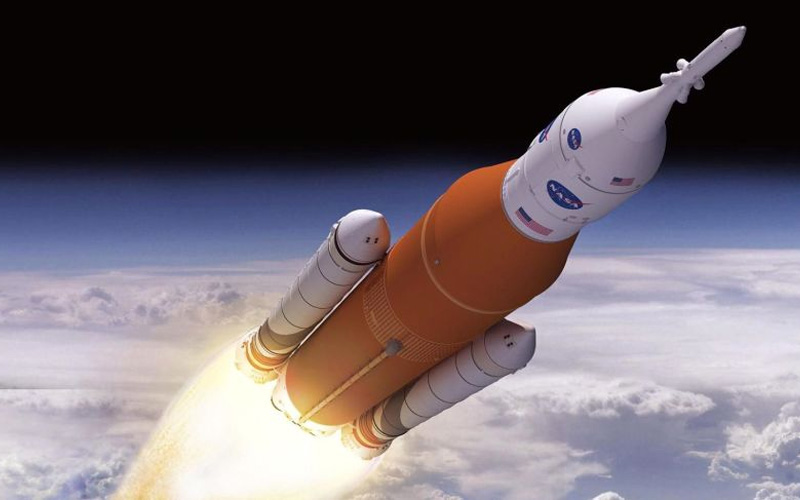Boeing’s Starliner crew capsule launched successfully, but a mishap prevented it from docking with the ISS. The ship is undamaged and will return and land at its designated location, according to officials. This could delay the planned crewed flight of the Starliner next summer.
Continue reading “Starliner Launches But it Can’t Reach the Station”Boeing and Airstream Show off Their New Astronaut Transport Vehicle: the Astrovan II
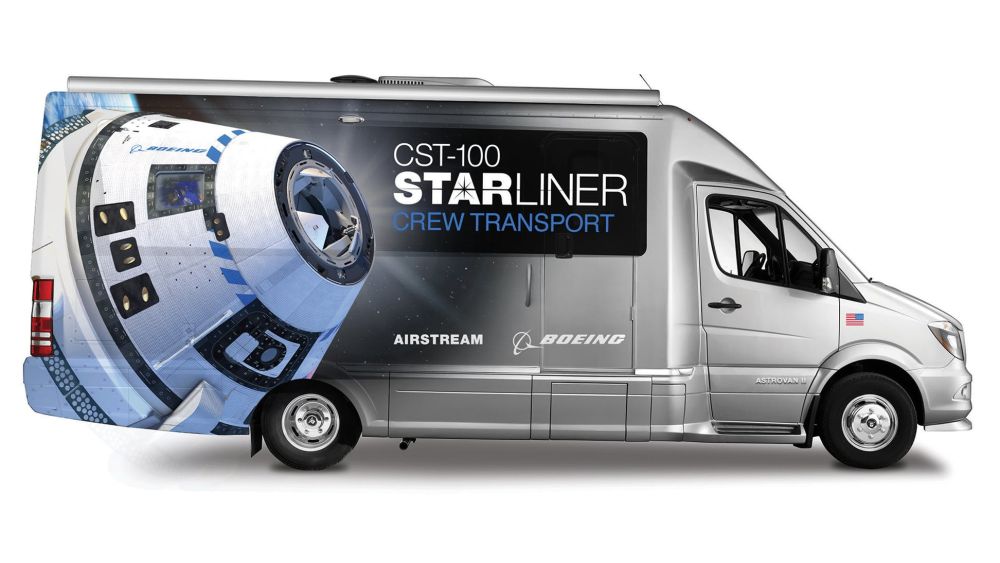
When it comes to brand recognition, Airstream‘s got game. Their silver, space-age looking travel trailers and touring coaches are iconic. Almost everyone recognizes their riveted aluminum bodies.
Continue reading “Boeing and Airstream Show off Their New Astronaut Transport Vehicle: the Astrovan II”SLS Rocket Promises To Do Better
A dramatic week in space launcher politics has left NASA’s Space Launch System (SLS) with a vastly reduced launch manifesto and casts doubt on the prospects of future upgrades to the massive launch vehicle.
On Monday the White House’s budget request laid out the administration’s plans for NASA’s coming years. For SLS there were three significant changes.
Continue reading “SLS Rocket Promises To Do Better”Dream Chaser Mini-Shuttle to Fly ISS Resupply Missions on ULA Atlas V
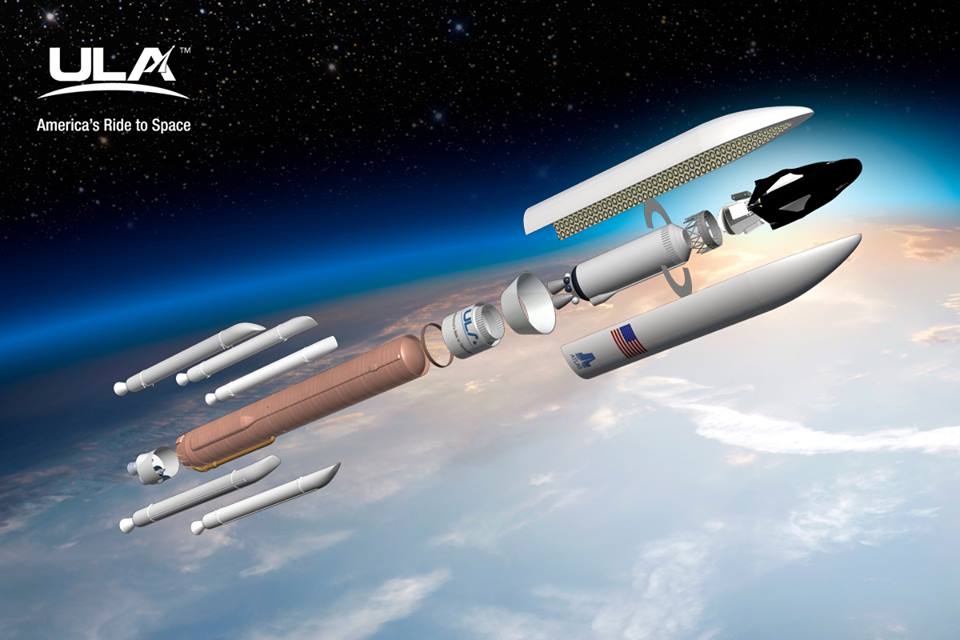

The first two missions of the unmanned Dream Chaser mini-shuttle carrying critical cargo to the International Space Station (ISS) for NASA will fly on the most powerful version of the Atlas V rocket and start as soon as 2020, announced Sierra Nevada Corporation (SNC) and United Launch Alliance (ULA).
“We have selected United Launch Alliance’s Atlas V rocket to launch our first two Dream Chaser® spacecraft cargo missions,” said SNC of Sparks, Nevada.
Dream Chaser will launch atop the commercial Atlas V in its most powerful configuration, dubbed Atlas V 552, with five strap on solid rocket motors and a dual engine Centaur upper stage while protectively tucked inside a five meter diameter payload fairing – with wings folded.
Blast off of Dream Chaser loaded with over 5500 kilograms of cargo mass for the space station crews will take place from ULA’s seaside Space Launch Complex-41 on Cape Canaveral Air Force Station in Florida.
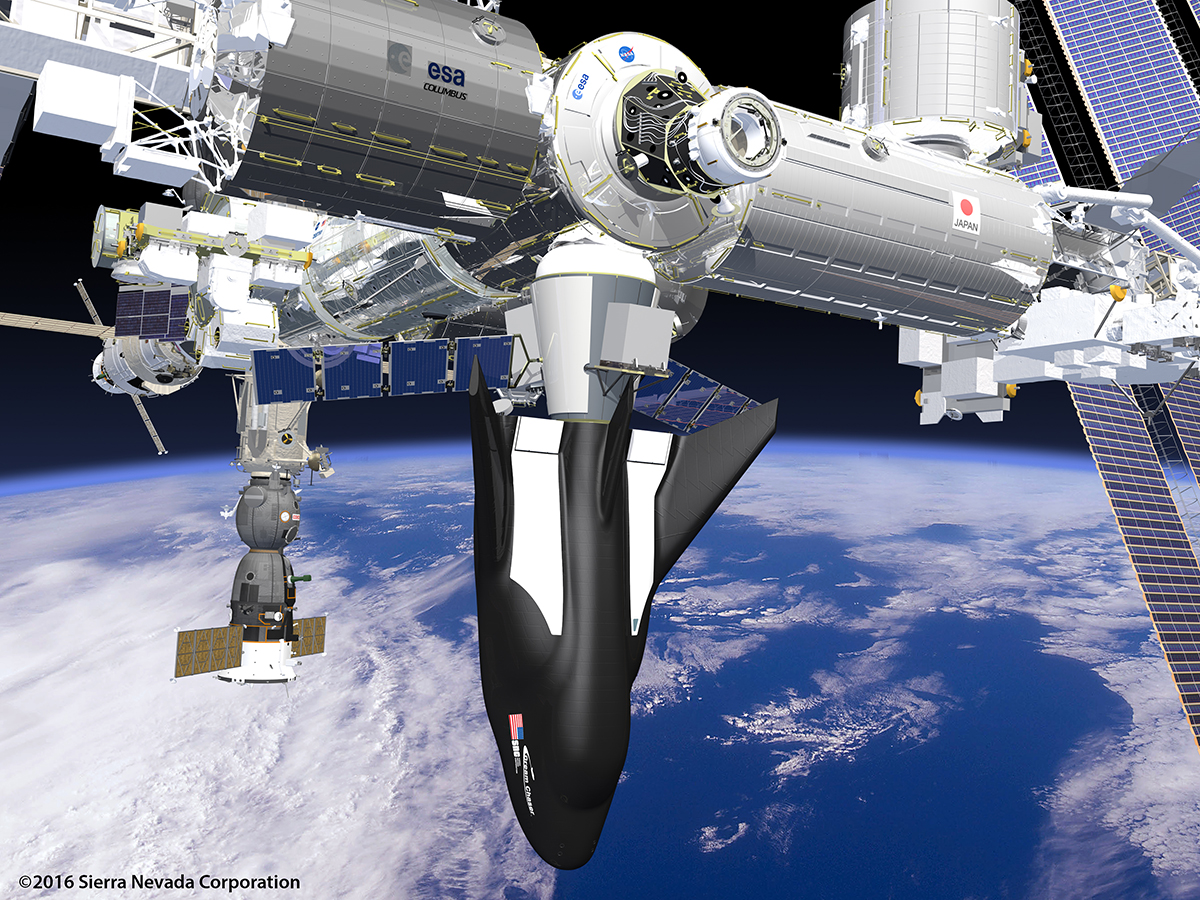
Credits: Sierra Nevada Corporation
The unique lifting body design enables runway landings for Dream Chaser, similar to the NASA’s Space Shuttle at the Shuttle Landing Facility runway at NASA’s Kennedy Space Center in Florida.
The ULA Atlas V enjoys a 100% success rate. It has also been chosen by Boeing to ferry crews on piloted missions of their CST-100 Starliner astronaut space taxi to the ISS and back. The Centaur upper stage will be equipped with two RL-10 engines for both Dream Chaser and Starliner flights.
“SNC recognizes the proven reliability of the Atlas V rocket and its availability and schedule performance makes it the right choice for the first two flights of the Dream Chaser,” said Mark Sirangelo, corporate vice president of SNC’s Space Systems business area, in a statement.
“Humbled and honored by your trust in us,” tweeted ULA CEO Tory Bruno following the announcement.
Liftoff of the maiden pair of Dream Chaser cargo missions to the ISS are expected in 2020 and 2021 under the Commercial Resupply Services 2 (CRS2) contract with NASA.
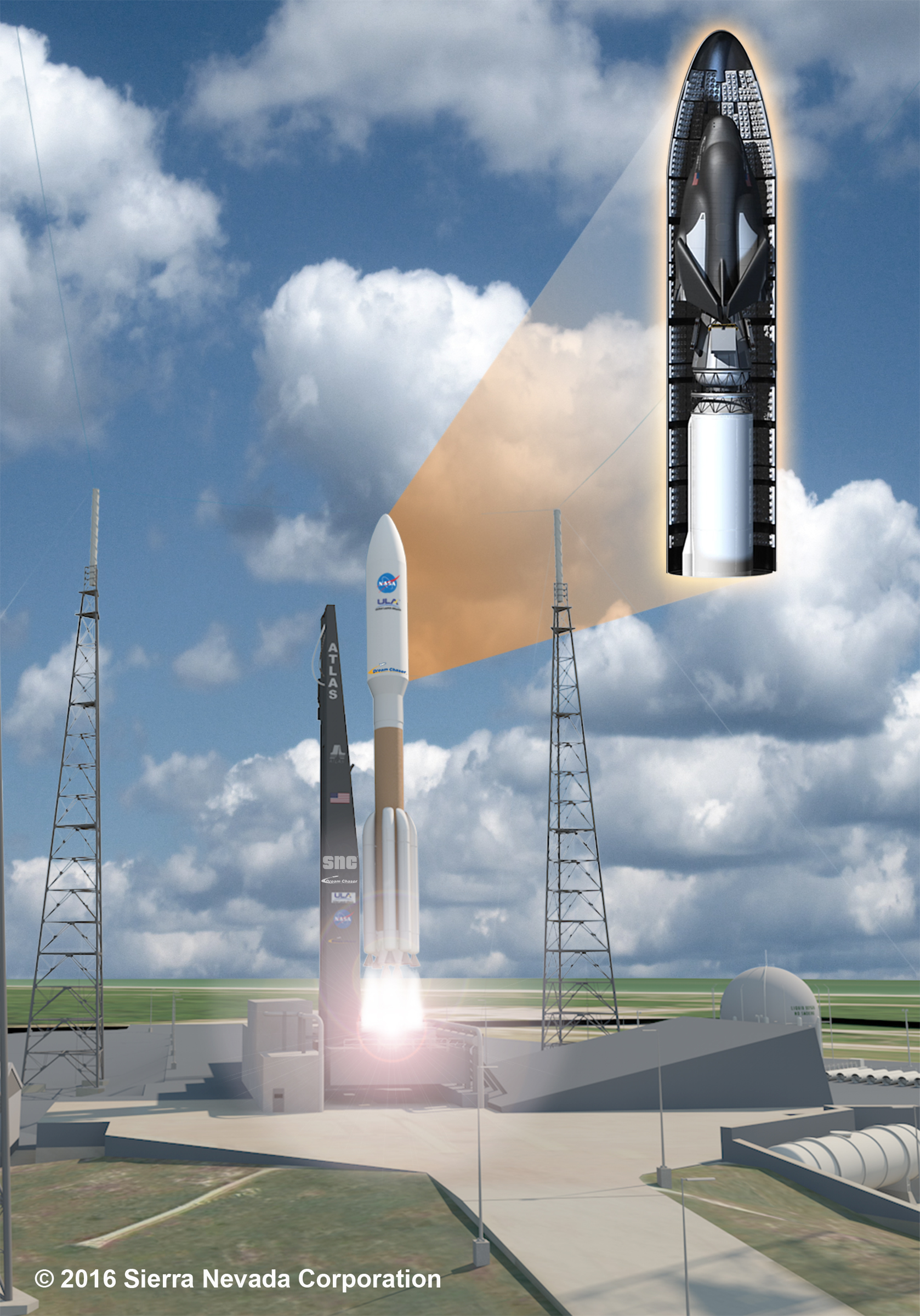
“ULA is pleased to partner with Sierra Nevada Corporation to launch its Dream Chaser cargo system to the International Space Station in less than three years,” said Gary Wentz, ULA vice president of Human and Commercial Systems.
“We recognize the importance of on time and reliable transportation of crew and cargo to Station and are honored the Atlas V was selected to continue to launch cargo resupply missions for NASA.”
By utilizing the most powerful variant of ULA’s Atlas V, Dream Chaser will be capable of transporting over 5,500 kilograms (12,000 pounds) of pressurized and unpressurized cargo mass – including science experiments, research gear, spare part, crew supplies, food, water, clothing and more per ISS mission.
“In addition, a significant amount of cargo, almost 2,000 kilograms is directly returned from the ISS to a gentle runway landing at a pinpoint location,” according to SNC.
“Dream Chaser’s all non-toxic systems design allows personnel to simply walk up to the vehicle after landing, providing immediate access to time-critical science as soon as the wheels stop.”
“ULA is an important player in the market and we appreciate their history and continued contributions to space flights and are pleased to support the aerospace community in Colorado and Alabama,” added Sirangelo.
Under the NASA CRS-2 contract awarded in 2016, Dream Chaser becomes the third ISS resupply provider, joining the current ISS commercial cargo vehicle providers, namely the Cygnus from Orbital ATK of Dulles, Virginia and the cargo Dragon from SpaceX of Hawthorne, California.
NASA decided to plus up the number of ISS commercial cargo providers from two to three for the critical task of ensuring the regular delivery of critical science, crew supplies, provisions, spare parts and assorted gear to the multinational crews living and working aboard the massive orbiting outpost.
NASA’s CRS-2 contracts run from 2019 through 2024 and specify six cargo missions for each of the three commercial providers.
By adding a new third provider, NASA simultaneously gains the benefit of additional capability and flexibility and also spreads out the risk.
Both SpaceX and Orbital ATK suffered catastrophic launch failures during ISS resupply missions, in June 2015 and October 2014 respectively, from which both firms have recovered.
Orbital ATK and SpaceX both successfully launched ISS cargo missions this year. Indeed a trio of Orbital ATK Cygnus spacecraft have already launched on the Atlas V, including the OA-7 resupply mission in April 2017.
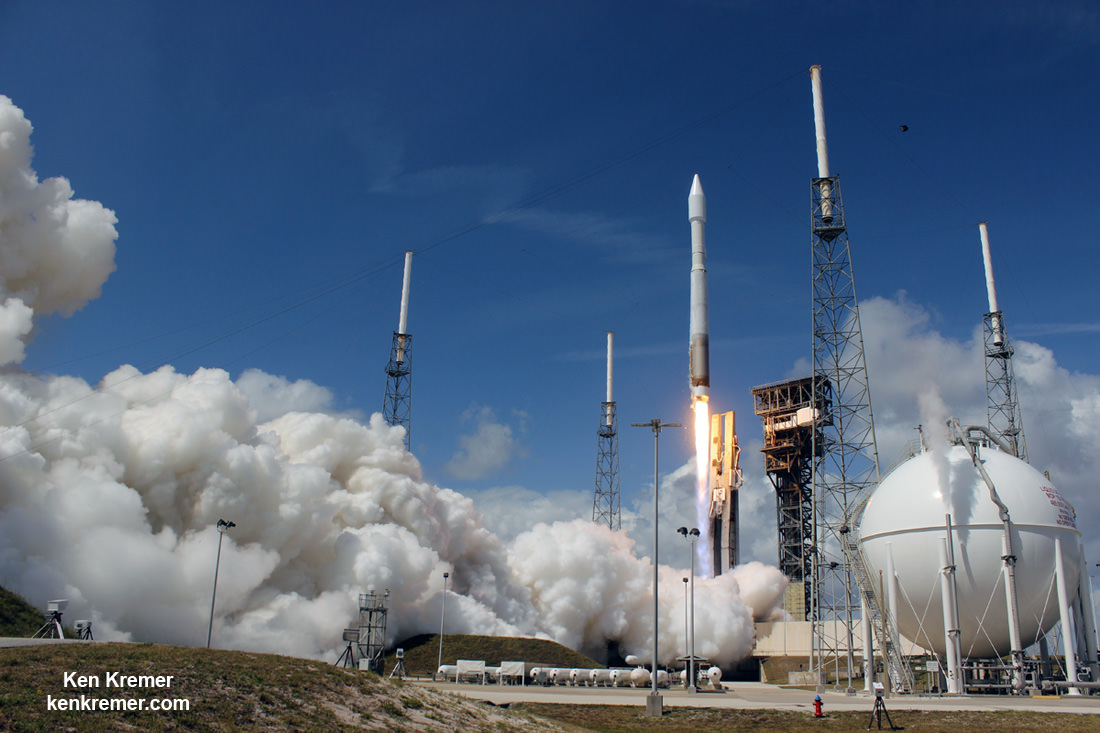
SpaceX has already launched a pair of resupply missions this year on the CRS-10 and CRS-11 flights in February and June 2017.
Unlike the Cygnus which burns up on reentry and Dragon which lands via parachutes, the reusable Dream Chaser is capable of low-g reentry and runway landings. This is very beneficial for sensitive scientific experiments and allows much quicker access by researchers to time critical cargo.
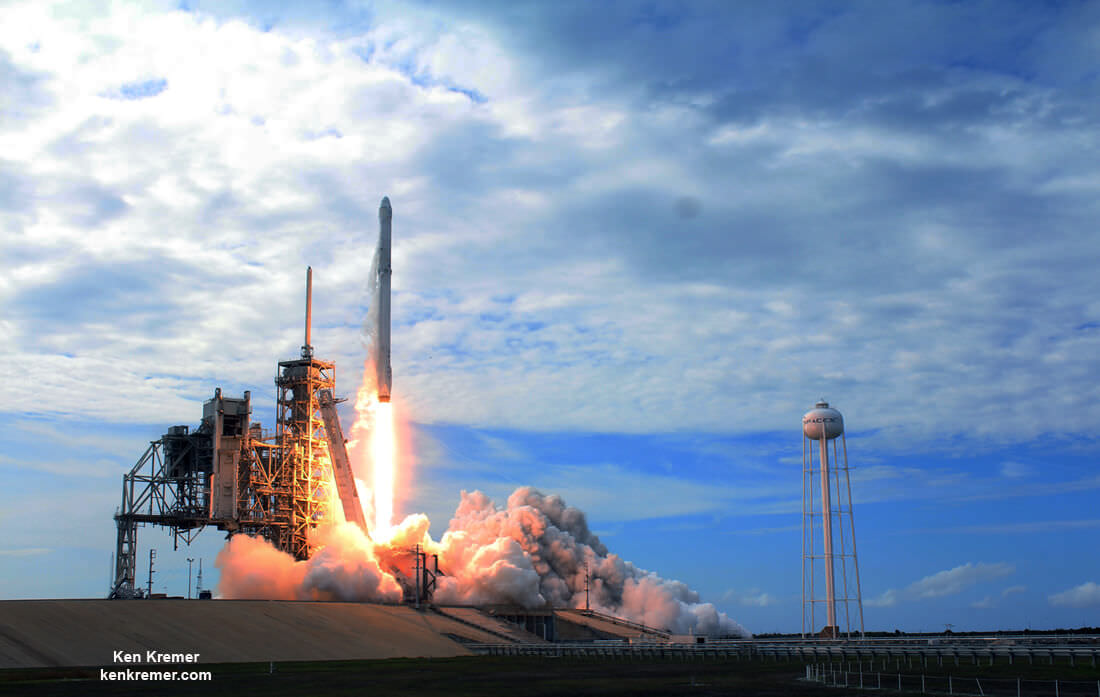
Dream Chaser has been under development for more than 10 years. It was originally developed as a manned vehicle and a contender for NASA’s commercial crew vehicles. When SNC lost the bid to Boeing and SpaceX in 2014, the company opted to develop this unmanned variant instead.
A full scale test version of the original Dream Chaser is currently undergoing ground tests at NASA’s Armstrong Flight Research Center in California. Approach and landing tests are planned for this fall.
Other current cargo providers to the ISS include the Russian Progress and Japanese HTV vessels.
Watch for Ken’s onsite space mission reports direct from the Kennedy Space Center and Cape Canaveral Air Force Station, Florida.
Stay tuned here for Ken’s continuing Earth and Planetary science and human spaceflight news.
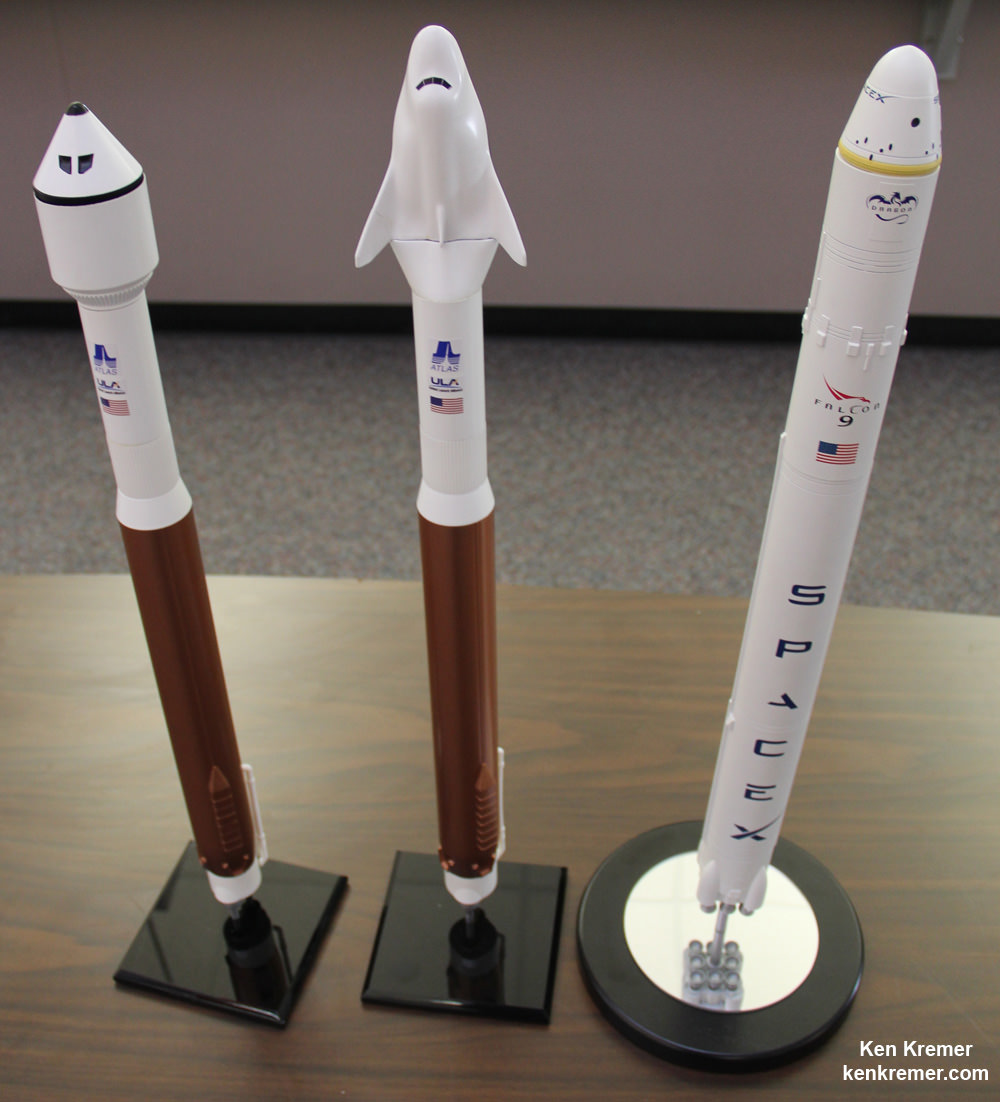
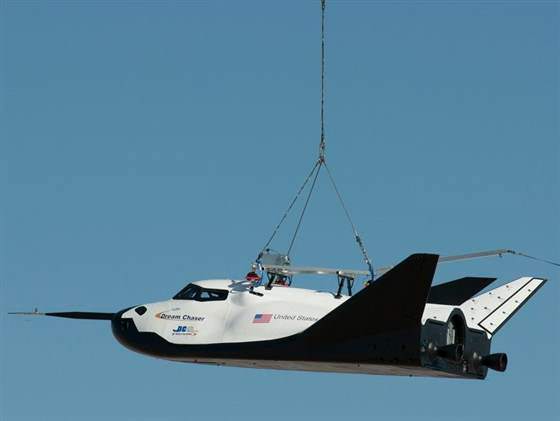
Clean Room Tour with NASA’s Next Gen Tracking Data Relay Satellite TDRS-M, Closeout Incident Under Review – Photos
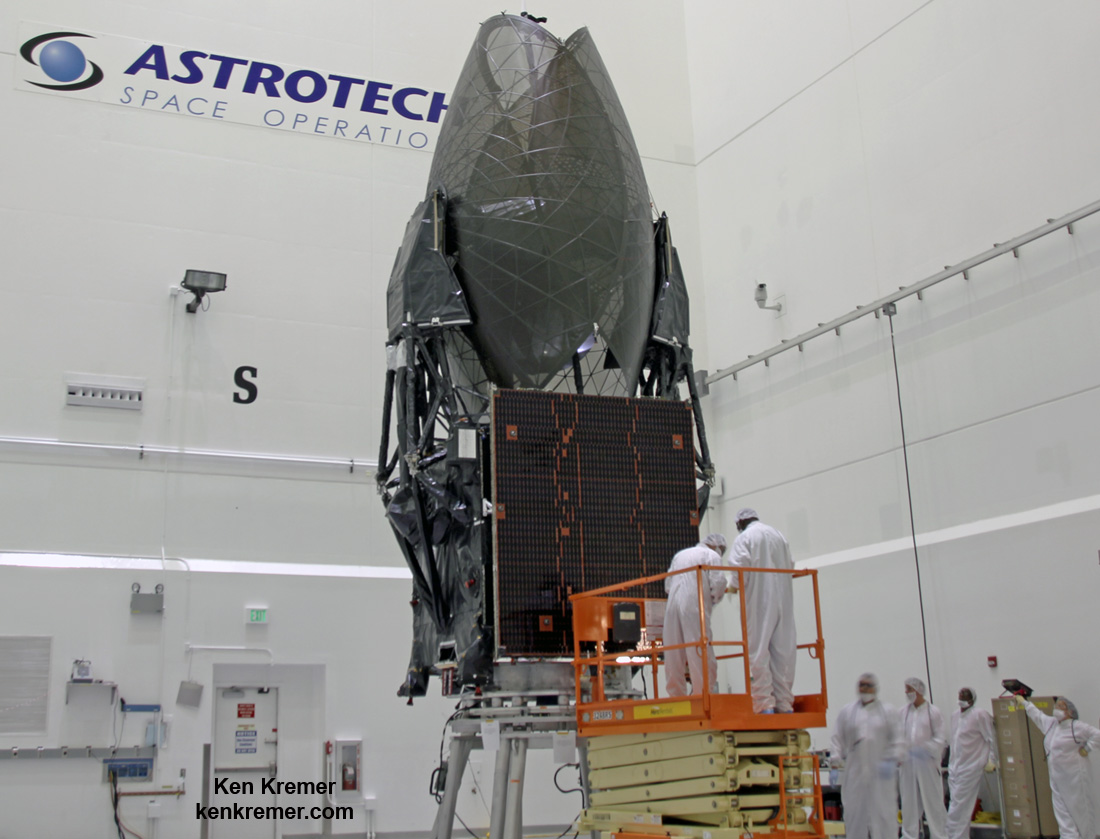

ASTROTECH SPACE OPERATIONS/KENNEDY SPACE CENTER, FL – The last of NASA’s next generation Tracking and Data Relay Satellites (TRDS) designed to relay critical science data and research observations gathered by the International Space Station (ISS), Hubble and dozens of Earth-orbiting Earth science missions is undergoing final prelaunch clean room preparations on the Florida Space Coast while targeting an early August launch – even as the agency reviews the scheduling impact of a weekend “closeout incident” that “damaged” a key component.
Liftoff of NASA’s $408 million eerily insectoid-looking TDRS-M science relay comsat atop a United Launch Alliance (ULA) Atlas V rocket currently scheduled for August 3 may be in doubt following a July 14 work related incident causing damage to the satellite’s Omni S-band antenna while inside the Astrotech Space Operations facility in Titusville, Florida.
“The satellite’s Omni S-band antenna was damaged during final spacecraft closeout activities,” NASA said in an updated status statement provided to Universe Today earlier today, July 16. NASA did not provide any further details when asked.
Everything had been perfectly on track as of Thursday, July 13 as Universe Today participated in an up close media tour and briefing about the massive probe inside the clean room processing facility at Astrotech Space Operations in Titusville, Fl.
On July 13, technicians were busily working to complete final spacecraft processing activities before its encapsulation inside the nose cone of the ULA Atlas V rocket she will ride to space, planned for the next day on July 14. The satellite and pair of payload fairings were stacked in separate high bays at Astrotech on July 13.
Alas the unspecified “damage” to the TDRS-M Omni S-band antenna unfortunately took place on July 14.
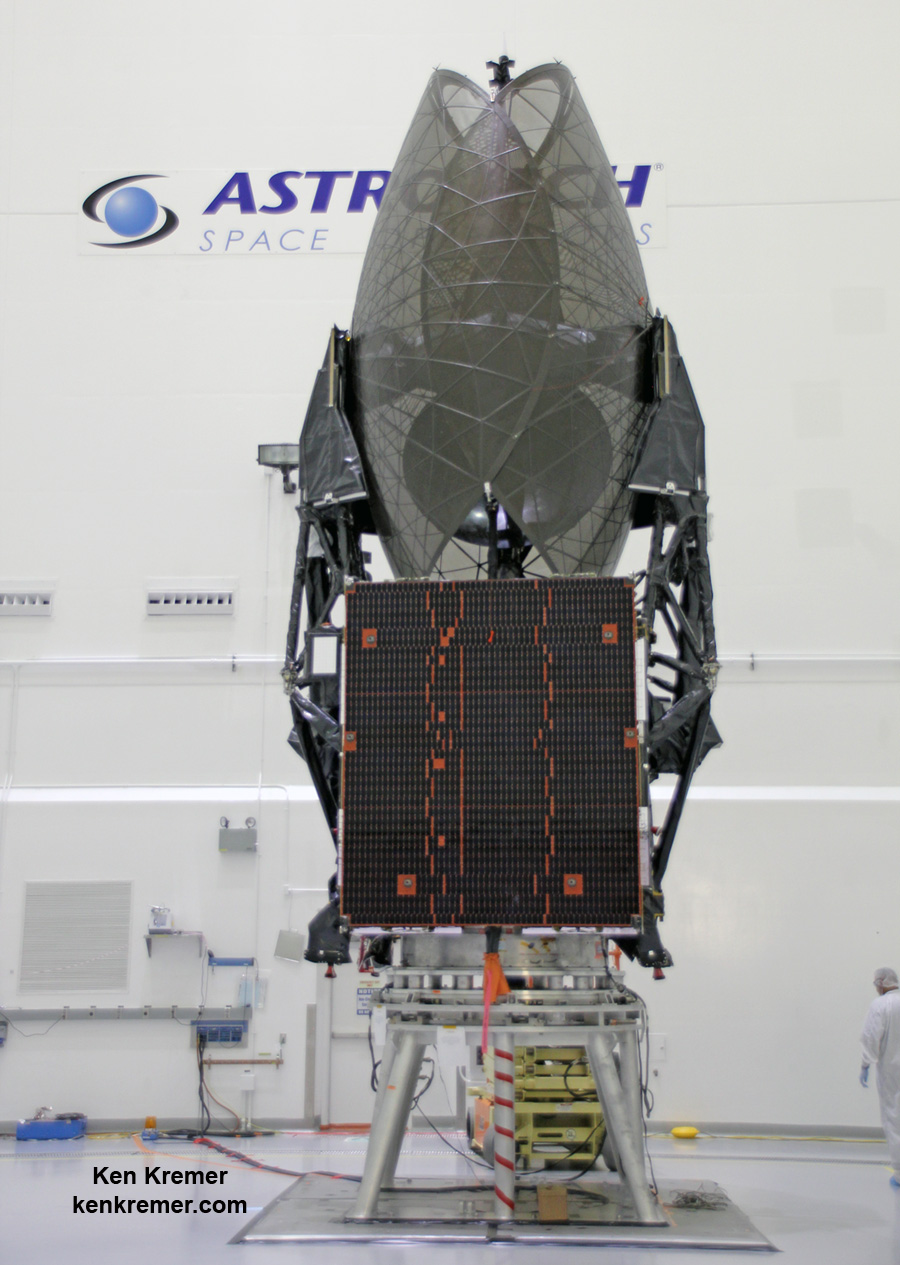
TDRS-M was built by Boeing and engineers are now analyzing the damage in a team effort with NASA. However it’s not known exactly during which closeout activity or by whom the damage occurred.
ULA CEO Tory Bruno tweeted that his company is not responsible and referred all questions to NASA. This may indicate that the antennae was not damaged during the encapsulation procedures inside the ULA payload fairing halves.
“NASA and Boeing are reviewing an incident that occurred with the Tracking and Data Relay Satellite (TDRS-M) on July 14 at Astrotech Space Operations in Titusville, Florida. The satellite’s Omni S-band antenna was damaged during final spacecraft closeout activities” stated NASA.
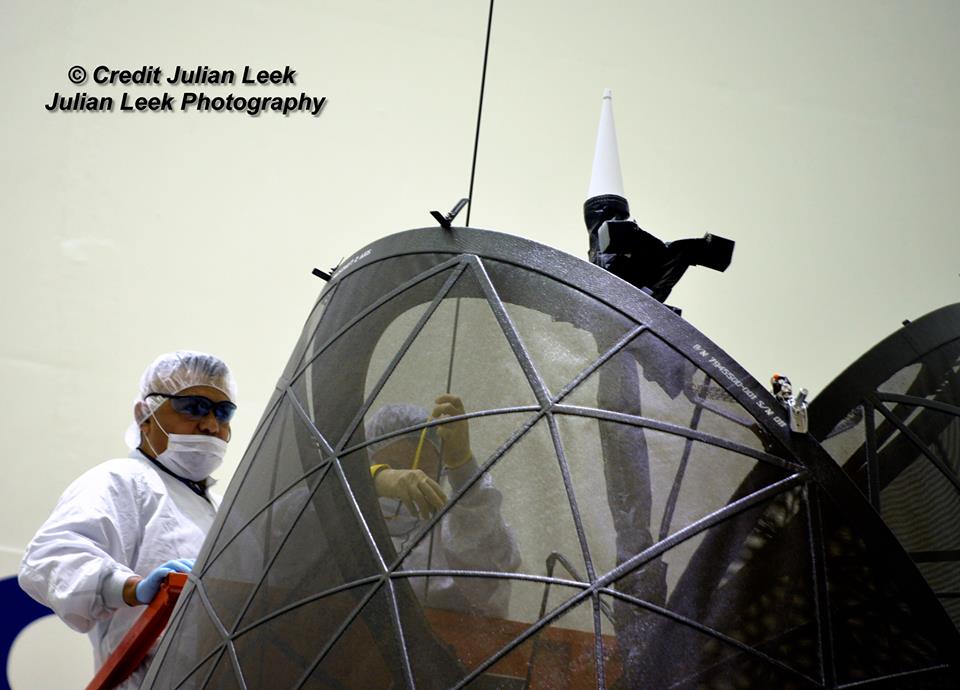
TDRS-M looks like a giant insect – or a fish depending on your point of view. It was folded into flight configuration for encapsulation in the clean room and the huge pair of single access antennas resembled a cocoon or a cicada. The 15 foot diameter single access antennas are large parabolic-style antennas and are mechanically steerable.
What does TDRS do? Why is it important? How does it operate?
“The existing Space Network of satellites like TDRS provide constant communications from other NASA satellites like the ISS or Earth observing satellites like Aura, Aqua, Landsat that have high bandwidth data that needs to be transmitted to the ground,” TDRS Deputy Project Manager Robert Buchanan explained to Universe Today during an interview in the Astrotech clean room.
“TRDS tracks those satellites using antennas that articulate. Those user satellites send the data to TDRS, like TDRS-M we see here and nine other TDRS satellites on orbit now tracking those satellites.”
“That data acquired is then transmitted to a ground station complex at White Sands, New Mexico. Then the data is sent to wherever those user satellites want the data to be sent is needed, such as a science data ops center or analysis center.”
Once launched and deployed in space they will “take about 30 to 40 days to fully unfurl,” Buchanan told me in the Astrotech clean room.
Astrotech is located just a few miles down the road from NASA’s Kennedy Space Center and the KSC Visitor Complex housing the finest exhibits of numerous spaceships, hardware items and space artifacts.
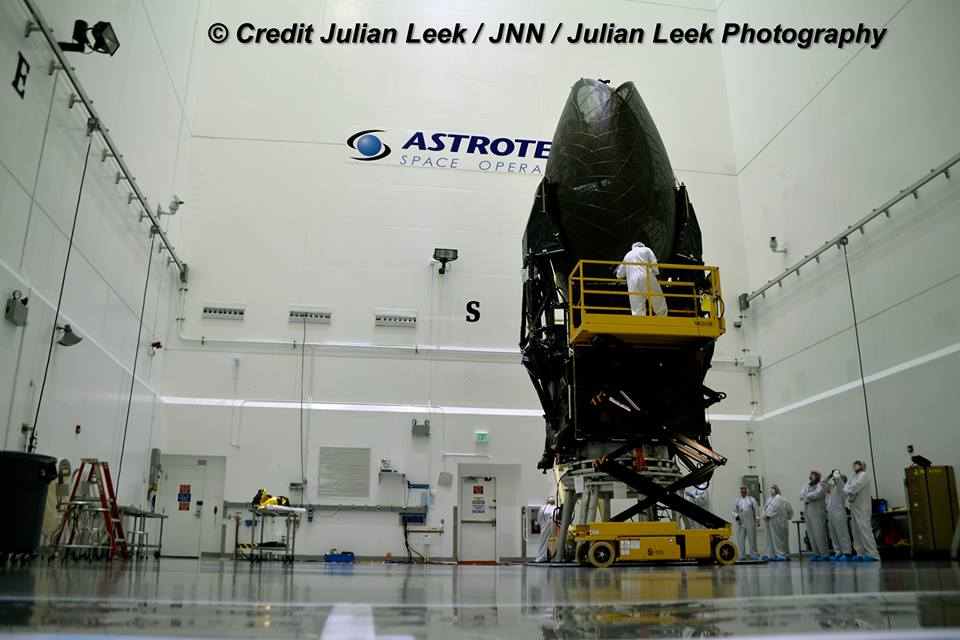
At this time, the TDRS-M website countdown clock is still ticking down towards a ULA Atlas V blastoff on August 3 at 9:02 a.m. EDT (1302 GMT) from Space Launch Complex 41 (SLC-41) on Cape Canaveral Air Force Station, for a late breakfast delight.
The Aug. 3 launch window spans 40 minutes from 9:02 to 9:42 a.m. EDT.
Whether or not the launch date will change depends on the results of the review of the spacecraft’s health by NASA and Boeing. Several other satellites are also competing for launch slots in August.
“The mission team is currently assessing flight acceptance and schedule. TDRS-M is planned to launch Aug. 3, 2017, on an United Launch Alliance (ULA) Atlas V rocket from Cape Canaveral Air Force Station in Florida,” NASA explained.
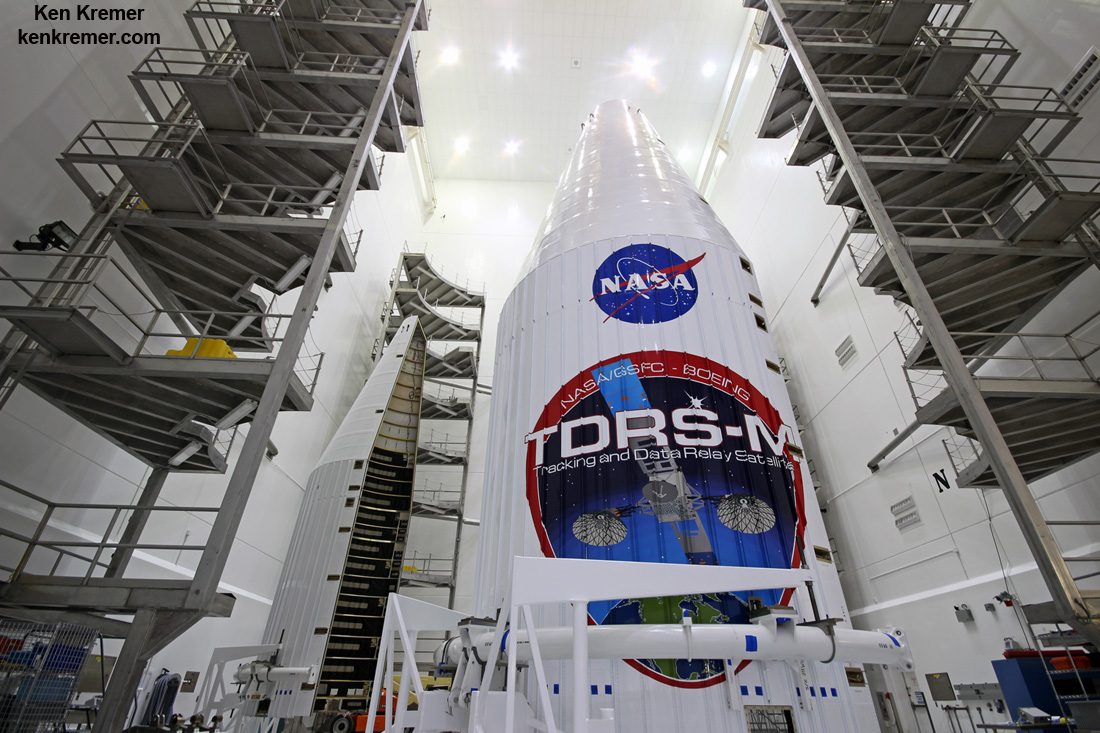
TDRS-M, spacecraft, which stands for Tracking and Data Relay Satellite – M is NASA’s new and advanced science data relay communications satellite that will transmit research measurements and analysis gathered by the astronaut crews and instruments flying abroad the International Space Station (ISS), Hubble Space Telescope and over 35 NASA Earth science missions including MMS, GPM, Aura, Aqua, Landsat, Jason 2 and 3 and more.
The TDRS constellation orbits 22,300 miles above Earth and provide near-constant communication links between the ground and the orbiting satellites.
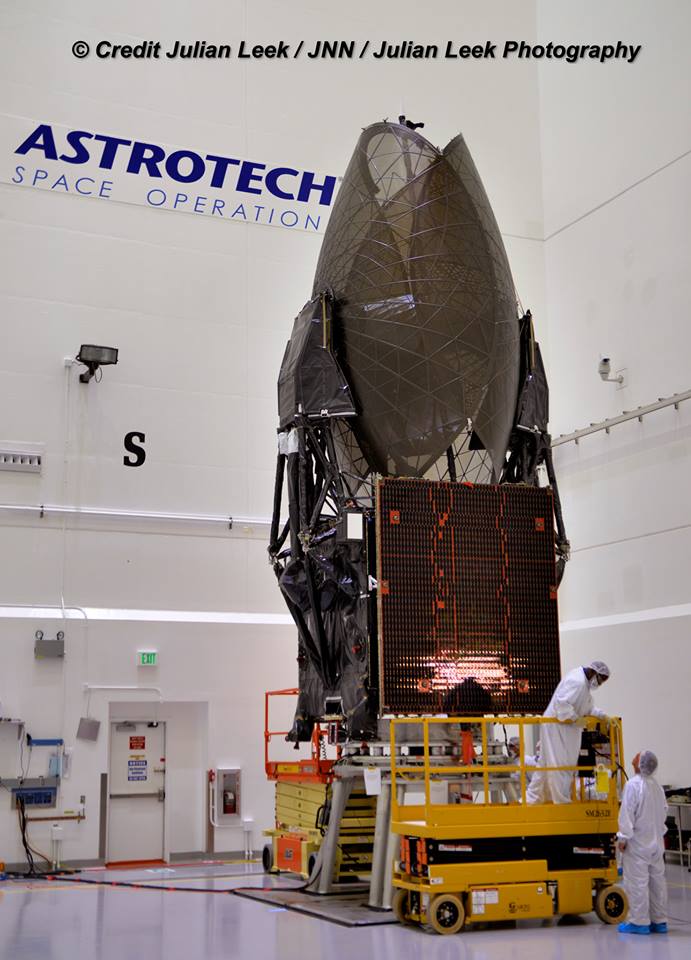
TRDS-M will have S-, Ku- and Ka-band capabilities. Ka has the capability to transmit as much as six-gigabytes of data per minute. That’s the equivalent of downloading almost 14,000 songs per minute says NASA.
The TDRS program is managed by NASA’s Goddard Space Flight Center in Greenbelt, Maryland.
TDRS-M is the third satellite in the third series of NASA’s American’s most powerful and most advanced Tracking and Data Relay Satellites. It is designed to last for a 15 year orbital lifetime.
The first TDRS satellite was deployed from the Space Shuttle Challenger in 1983 as TDRS-A.
TDRS-M was built by prime contractor Boeing in El Segundo, California and is the third of a three satellite series – comprising TDRS -K, L, and M. They are based on the Boeing 601 series satellite bus and will be keep the TDRS satellite system operational through the 2020s.
TDSR-K and TDRS-L were launched in 2013 and 2014.
The Tracking and Data Relay Satellite project is managed at NASA’s Goddard Space Flight Center.
TDRS-M was built as a follow on and replacement satellite necessary to maintain and expand NASA’s Space Network, according to a NASA description.
The gigantic satellite is about as long as two school buses and measures 21 meters in length by 13.1 meters wide.
It has a dry mass of 1800 kg (4000 lbs) and a fueled mass of 3,454 kilogram (7,615 lb) at launch.
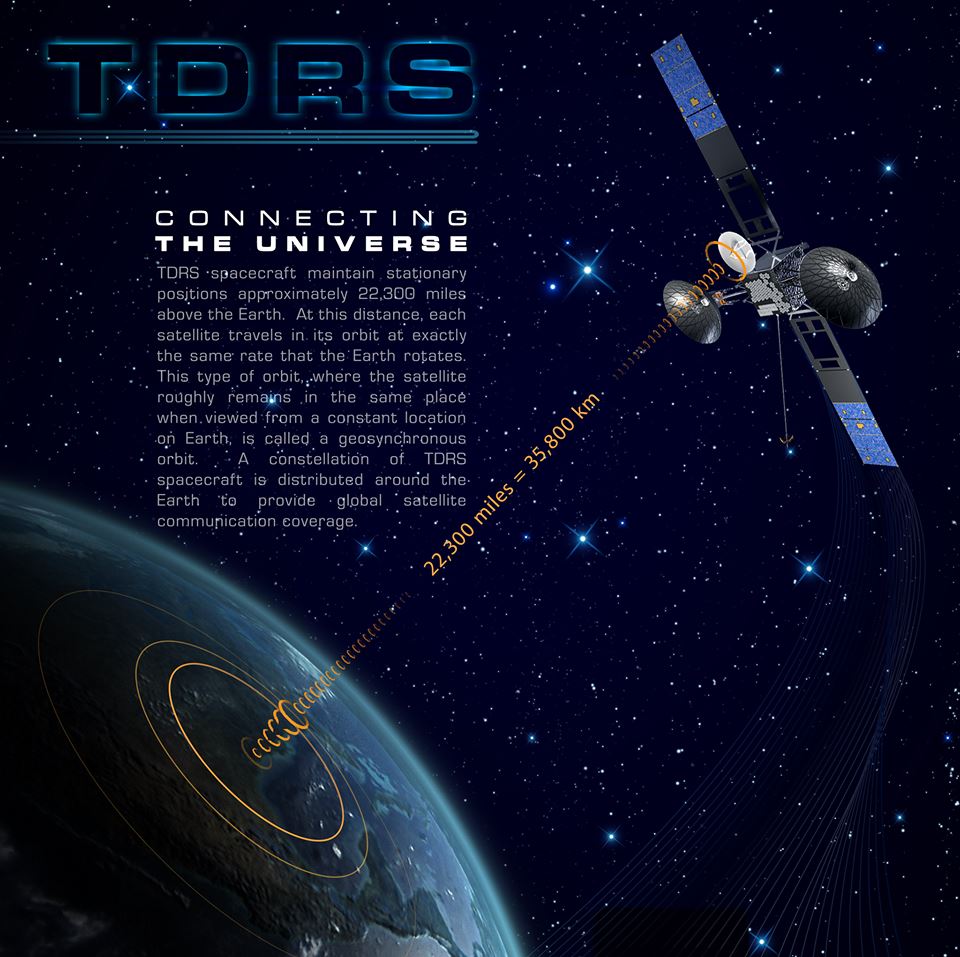
TDRS-M will blastoff on a ULA Atlas V in the baseline 401 configuration, with no augmentation of solid rocket boosters on the first stage. The payload fairing is 4 meters (13.1 feet) in diameter and the upper stage is powered by a single-engine Centaur.
TDRS-M will be launched to a Geostationary orbit some 22,300 miles (35,800 km) above Earth.
“The final orbital location for TDRS-M has not yet been determined,” Buchanen told me.
The Atlas V booster is being assembled inside the Vertical Integration Facility (VIF) at SLC-41 and will be rolled out to the launch pad the day before liftoff with the TDRS-M science relay comsat comfortably encapsulated inside the nose cone.
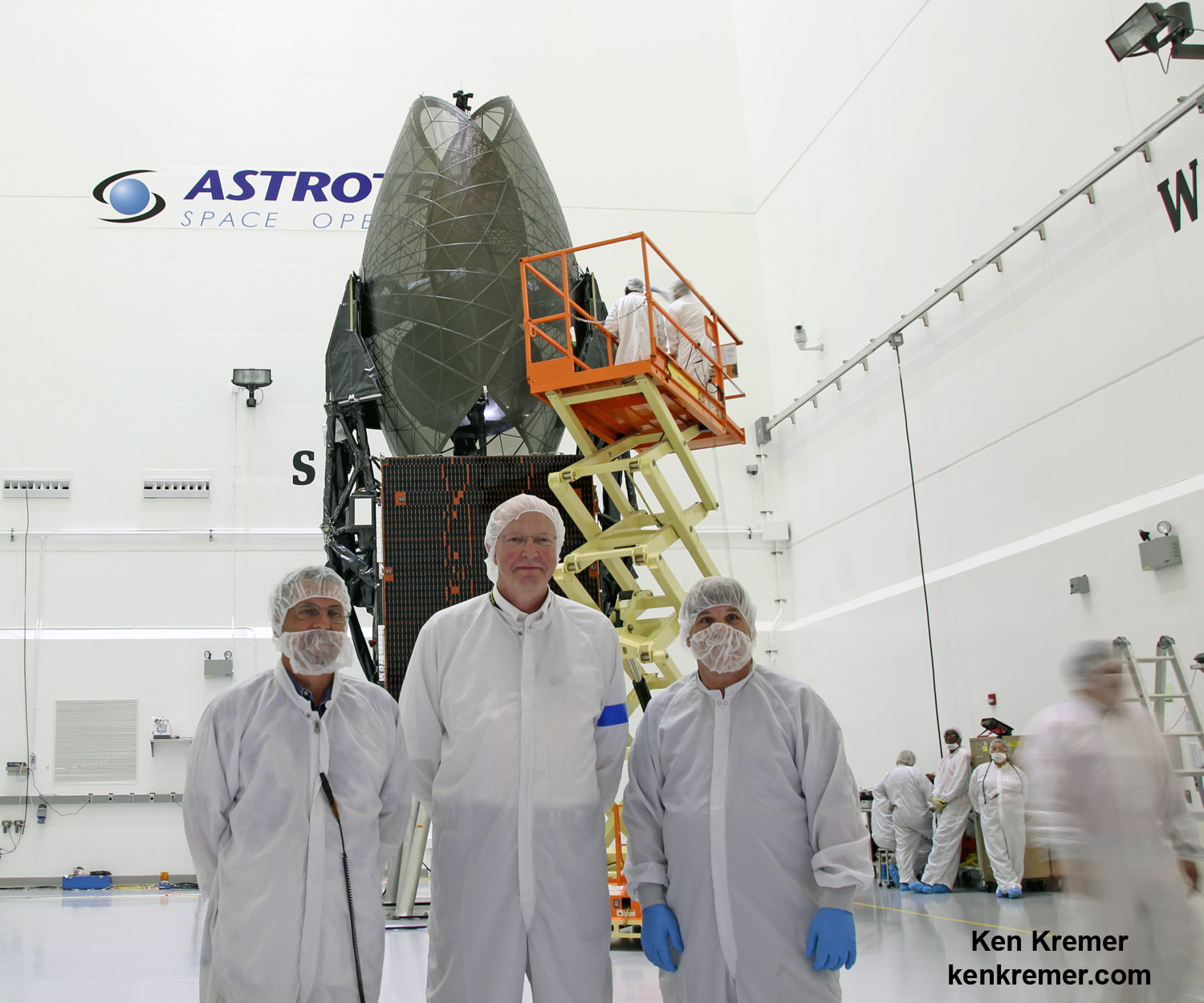
Carefully secured inside its shipping container, the TDRS-M satellite was transported on June 23 by a US Air Force cargo aircraft from Boeing’s El Segundo, California facility to Space Coast Regional Airport in Titusville, Florida, for preflight processing at Astrotech.
Watch for Ken’s onsite TDRS-M and space mission reports direct from the Kennedy Space Center and Cape Canaveral Air Force Station, Florida.
Stay tuned here for Ken’s continuing Earth and Planetary science and human spaceflight news.
KSC Director/Shuttle Commander Robert Cabana Talks NASA 2018 Budget- ‘Stay on the path’ with SLS, Orion, Commercial Crew: One-on-One Interview


KENNEDY SPACE CENTER VISITOR COMPLEX, FL – Following up last week’s announcement of NASA’s proposed Fiscal Year 2018 top line budget of $19.1 Billion by the Trump Administration, Universe Today spoke to NASA’ s Kennedy Space Center (KSC) Director Robert Cabana to get his perspective on the new budget and what it means for NASA and KSC; “Stay on the path!” – with SLS, Orion, ISS and Commercial Crew was his message in a nutshell.
The highlights of NASA’s $19.1 Billion FY 2018 budget request were outlined last week by NASA Acting Administrator Robert Lightfoot during a ‘State of NASA’ speech to agency employees held at NASA HQ, Washington, D.C. and broadcast to the public live on NASA TV on May 23.
In order to get a better idea of the implications of the 2018 NASA budget proposal for KSC, I spoke one-on-one with Robert Cabana – one of NASA’s top officials, who currently serves as Director of the Kennedy Space Center (KSC) as well as being a former astronaut and Space Shuttle Commander. Cabana is a veteran of four space shuttle missions.
How did NASA and KSC fare with the newly announced 2018 Budget?
“We at KSC and NASA as a whole did very well with the 2018 budget,” KSC Director Robert Cabana explained during an interview with Universe Today by the Rocket Garden at the Kennedy Space Center Visitor Complex (KSCVC) in Florida.
“I think it really solidifies that the President has confidence in us, on the path that we are on,” Cabana noted while attending a student robotics competition at KSCVC sponsored by NASA.
“With only a 1 percent cut – when you look at what other agency’s got cut – this budget allows us to stay on the path that we are on.”
Trump cut NASA’s 2018 budget request by $0.5 Billion compared to the recently enacted FY 2017 budget of $19.6 Billion approved by the US Congress and signed by the President.
Other Federal science agency’s also critically vital to the health of US scientific research such as the NIH, the NSF, the EPA, DOE and NIST suffered terrible double digit slashes of 10 to 20% or more.
KSC is the focal point for NASA’s human spaceflight programs currently under intense development by NASA – namely the Space Launch System (SLS) Mars megarocket, the Orion deep space crew capsule to be launched beyond Earth orbit (BEO) atop SLS, and the duo of Commercial Crew Program (CCP) space taxis being manufactured by Boeing and SpaceX that will ferry our astronauts to low Earth orbit (LEO) and the International Space Station (ISS).
Numerous NASA science missions also launch from the Florida Space Coast.
“At KSC the budget keeps us on a path that continues to provide a commercial crew vehicle to fly crews to the ISS in 2018,” Cabana stated.
“The budget also keeps us on track to launch SLS and Orion in 2019.”
“I think that’s really important – along with all the other stuff we are doing here at KSC.”
“From our point of view it’s a good budget. We need to press ahead and continue on with what we promised.”
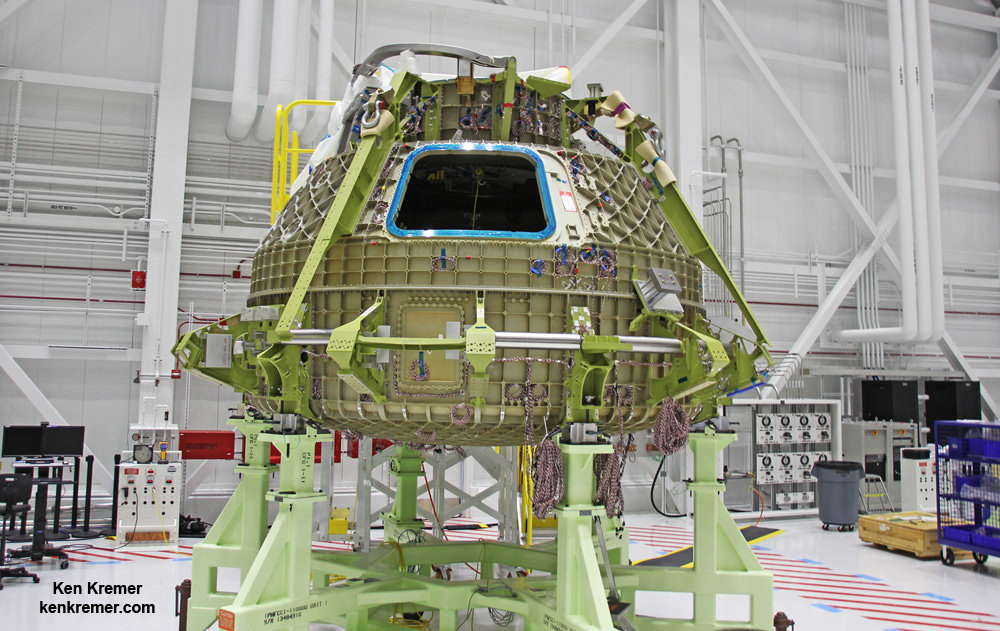
What’s ahead for commercial crew at KSC?
“We are moving forward with commercial crew,” Cabana told me.
“Within the next calendar year [2018] we are moving ahead with flying the first certification flight with crew to the ISS. So that’s test flights and by the end of the year an actual crewed flight to the ISS. I want to see that happen.”

Industry partners Boeing and SpaceX are building the private CST-100 Starliner and Crew Dragon spaceships respectively, as part of NASA’s commercial crew initiative aimed at restoring America’s human spaceflight capability to launch our astronauts aboard American spaceships on American rockets from American soil.
Commercial Crew is a public/private partnership initiative with commercial contracts valued at $4.2 Billion and signed by Boeing and SpaceX with NASA in September 2014 under the Obama Administration.
The goal of commercial crew is to end our sole reliance on the Russian Soyuz capsule for astronaut flights to the space station since the retirement of the space shuttles back in 2011 – by manufacturing indigenous rockets and human rated spaceships.
However the CCP program suffered severe budget reductions by the US Congress for several years which forced significant work stretch-outs and delays in the maiden crew launches by both companies from 2015 to 2018 – and thus forced additional payments to the Russians for Soyuz seat purchases.
Both the Boeing Starliner and SpaceX Dragon crew vehicles can carry 4 or more astronauts to the ISS. This will enable NASA to add another crew member and thereby enlarge the ISS crew from 6 to 7 permanent residents after they become operational.

Meanwhile NASA is focusing on developing the SLS heavy lift rocket and Orion crew capsule with prime contractors Boeing and Lockheed Martin in an agency wide effort to send humans on a ‘Journey to Mars’ in the 2030s.
The European Space Agency(ESA) is also partnered with NASA and providing the service module for Orion.
What’s the status of the delivery of the European Space Agency’s service module?
“The service module will be here sometime next year,” Cabana said.
He noted that the details and exact timing are yet to be determined.
The first integrated launch of SLS and Orion on the unpiloted Exploration Mission-1 (EM-1) is now slated for sometime in 2019 after NASA recently slipped the date to the right from Fall 2018.
At the request of the Trump Administration, NASA also just completed a detailed study to ascertain the feasibility of adding a crew of two NASA astronauts to the EM-1 flight and launch it by the end of 2019.
In the end, NASA officials decided to stick with the baselined plan of no crew on EM-1 for a variety of technical and safety reasons, as well as cost – as I reported here.
I asked Cabana for his insight and opinion on NASA not adding crew to Orion on the EM-1 flight.
“No we are not launching crew on the first flight [EM-1],” Cabana stated.
“With the budget that we have and what we need to do, this is the answer we got to at the end.”
“You know the crew study was still very important. It allowed us to find some things that we should still do on [EM-1], even though we are not going to launch crew on that flight.
“So we will make some further modifications that will reduce the risk even further when we do fly crew [on the next flight of EM-2].”
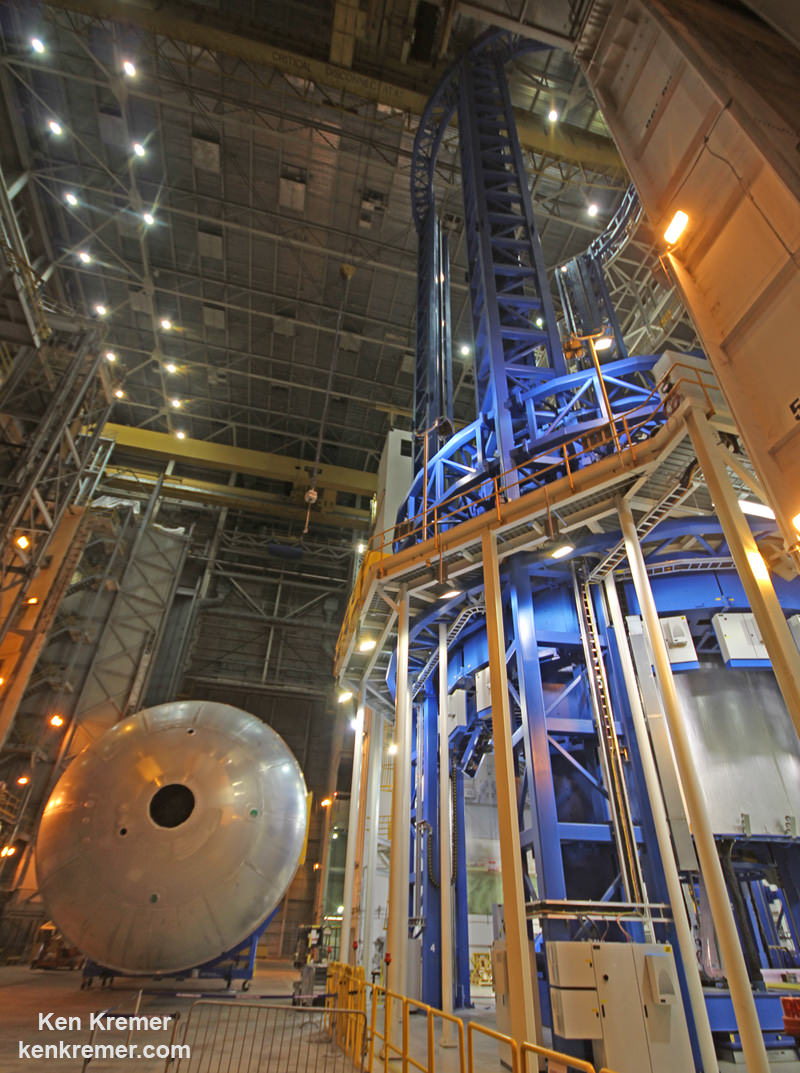
So for 2017 what are the major milestone you hope to complete here at KSC for SLS and Orion?
“So for me here at the Kennedy Space Center, my goal for the end of this calendar year 2017 we will have completed all of the construction of all of the [ground systems] hardware and facilities that are necessary to process and launch the Space Launch System (SLS) and Orion,” Cabana elaborated.
‘We will still have a lot of work to do with the software for the spacecraft command and control systems and the ground systems.”
“But my goal is to have the hardware for the ground systems complete by the end of this year.”
What are those KSC facilities?
“Those facilities include the VAB [Vehicle Assembly Building] which will be complete to accept the mobile launcher in September and pad 39B will be complete in August,” Cabana said.
“The RPSF is already complete. The NPFF is already complete and we are doing testing in there. The LASF [Launch Abort System Facility] is complete – where they put the abort rocket on.”
“The Mobile Launcher will be complete from a structural point of view, with all the systems installed by the end of the year [including the umbilical’s and while room].”
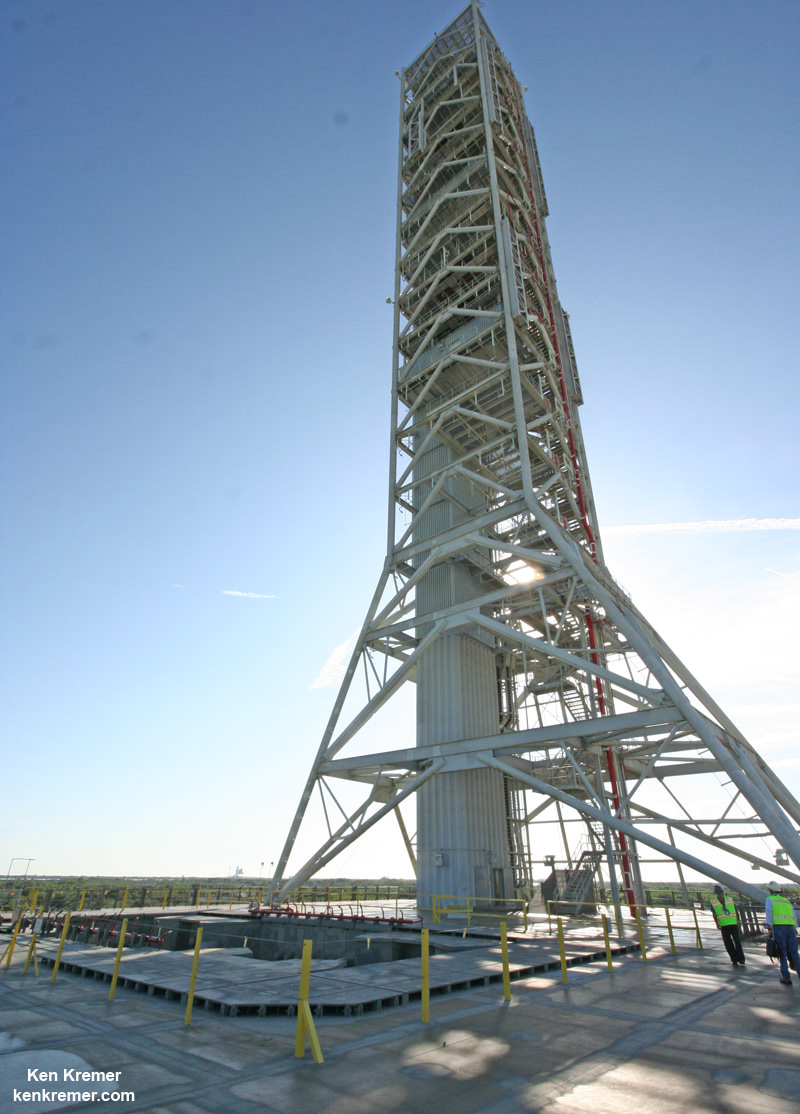
Watch for Ken’s onsite CRS-11 mission reports direct from the Kennedy Space Center and Cape Canaveral Air Force Station, Florida.
Stay tuned here for Ken’s continuing Earth and Planetary science and human spaceflight news.
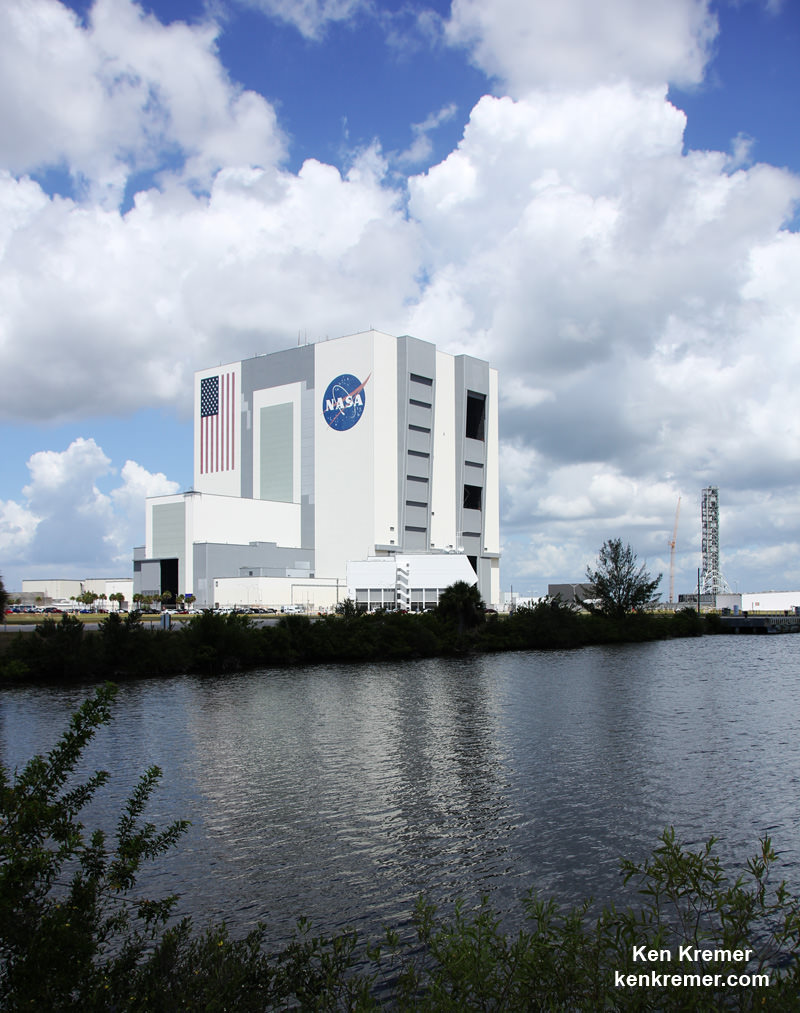
.……….
Learn more about the SpaceX Dragon CRS-11 resupply launch to ISS, NASA missions and more at Ken’s upcoming outreach events at Kennedy Space Center Quality Inn, Titusville, FL:
May 30/31: “SpaceX CRS-11 and CRS-10 resupply launches to the ISS, Inmarsat 5 and NRO Spysat, EchoStar 23, SLS, Orion, Commercial crew capsules from Boeing and SpaceX , Heroes and Legends at KSCVC, ULA Atlas/John Glenn Cygnus launch to ISS, SBIRS GEO 3 launch, GOES-R weather satellite launch, OSIRIS-Rex, Juno at Jupiter, InSight Mars lander, SpaceX and Orbital ATK cargo missions to the ISS, ULA Delta 4 Heavy spy satellite, Curiosity explores Mars, Pluto and more,” Kennedy Space Center Quality Inn, Titusville, FL, evenings

Trump Proposes $19.1 Billion 2018 NASA Budget, Cuts Earth Science and Education
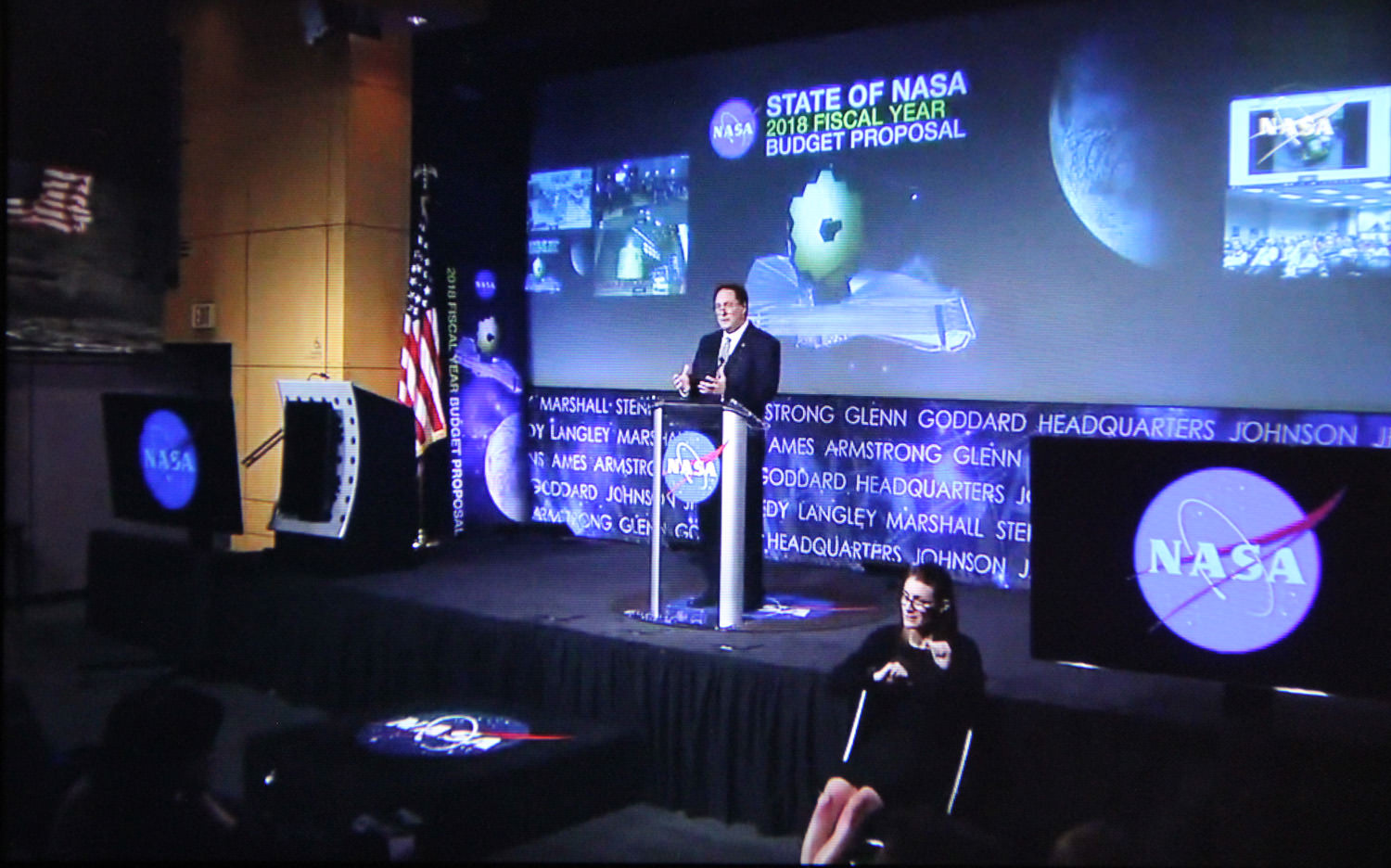

The Trump Administration has proposed a $19.1 Billion NASA budget request for Fiscal Year 2018, which amounts to a $0.5 Billion reduction compared to the recently enacted FY 2017 NASA Budget. Although it maintains many programs such as human spaceflight, planetary science and the Webb telescope, the budget also specifies significant cuts and terminations to NASA’s Earth Science and manned Asteroid redirect mission as well as the complete elimination of the Education Office.
Overall NASA’s FY 2018 budget is cut approximately 3%, or $560 million, for the upcoming fiscal year starting in October 2017 as part of the Trump Administration’s US Federal Budget proposal rolled out on May 23, and quite similar to the initial outline released in March.
The cuts to NASA are smaller compared to other Federal science agencies also absolutely vital to the health of US scientific research – such as the NIH, the NSF, the EPA, DOE and NIST which suffer unconscionable double digit slashes of 10 to 20% or more.
The highlights of NASA’s FY 2018 Budget were announced by NASA acting administrator Robert Lightfoot during a ‘State of NASA’ speech to agency employees held at NASA HQ, Washington, D.C. and broadcast to the public live on NASA TV.
Lightfoot’s message to NASA and space enthusiasts was upbeat overall.
“What this budget tells us to do is to keep going!” NASA acting administrator Robert Lightfoot said.
“Keep doing what we’ve been doing. It’s very important for us to maintain that course and move forward as an agency with all the great things we’re doing.”
“I want to reiterate how proud I am of all of you for your hard work – which is making a real difference around the world. NASA is leading the world in space exploration, and that is only possible through all of your efforts, every day.”
“We’re pleased by our top line number of $19.1 billion, which reflects the President’s confidence in our direction and the importance of everything we’ve been achieving.”
Lightfoot recalled the recent White House phone call from President Trump to NASA astronaut & ISS Station Commander Peggy Whitson marking her record breaking flight for the longest cumulative time in space by an American astronaut.
Thus Lightfoot’s vision for NASA has three great purposes – Discover, Explore, and Develop.
“NASA has a historic and enduring purpose. It can be summarized in three major strategic thrusts: Discover, Explore, and Develop. These correspond to our missions of scientific discovery, missions of exploration, and missions of new technology development in aeronautics and space systems.”
Lightfoot further recounted the outstanding scientific accomplishments of NASA’s Mars rover and orbiters paving the path for the agencies plans to send humans on a ‘Journey to Mars’ in the 2030s.
“We’ve had a horizon goal for some time now of reaching Mars, and this budget sustains that work and also provides the resources to keep exploring our solar system and look beyond it.”
Lightfoot also pointed to upcoming near term science missions- highlighting a pair of Mars landers – InSIGHT launching next year as well as the Mars 2020 rover. Also NASA’s next great astronomical observatory – the James Webb Space Telescope (JWST).
“In science, this budget supports approximately 100 missions: 40 missions currently preparing for launch & 60 operating missions.”
“The James Webb Space Telescope is built!” Lightfoot gleefully announced.
“It’s done testing at Goddard and now has moved to Johnson for tests to simulate the vacuum of space.”
JWST is the scientific successor to the Hubble Space Telescope and slated for launch in Oct. 2018. The budget maintains steady support for Webb.

The Planetary Sciences division receives excellent support with a $1.9 Billion budget request. It includes solid support for the two flagship missions – Mars 2020 and Europa Clipper as well as the two new Discovery class missions selected -Lucy and Psyche.
“The budget keeps us on track for the next selection for the New Frontiers program, and includes formulation of a mission to Jupiter’s moon Europa.”
“SLS and Orion are making great progress. They are far beyond concepts, and as I mentioned, components are being tested in multiple ways right now as we move toward the first flight of that integrated system.”
NASA is currently targeting the first integrated launch of SLS and Orion on the uncrewed Exploration Mission-1 (EM-1) for sometime in 2019.
Top NASA managers recently decided against adding a crew of two astronauts to the flight after conducting detailed agency wide studies at the request of the Trump Administration.
NASA would have needed an additional $600 to $900 to upgrade EM-1 with humans.
Unfortunately Trump’s FY 2018 NASA budget calls for a slight reduction in development funding for both SLS and Orion – thus making a crewed EM-1 flight fiscally unviable.

The budget request does maintain full funding for both of NASA’s commercial crew vehicles planned to restore launching astronauts to low Earth orbit (LEO) and the ISS from US soil on US rockets – namely the crewed Dragon and CST-100 Starliner – currently under development by SpaceX and Boeing – thus ending our sole reliance on Russian Soyuz for manned launches.
“Working with commercial partners, NASA will fly astronauts from American soil on the first new crew transportation systems in a generation in the next couple of years.”
“We need commercial partners to succeed in low-Earth orbit, and we also need the SLS and Orion to take us deeper into space than ever before.”
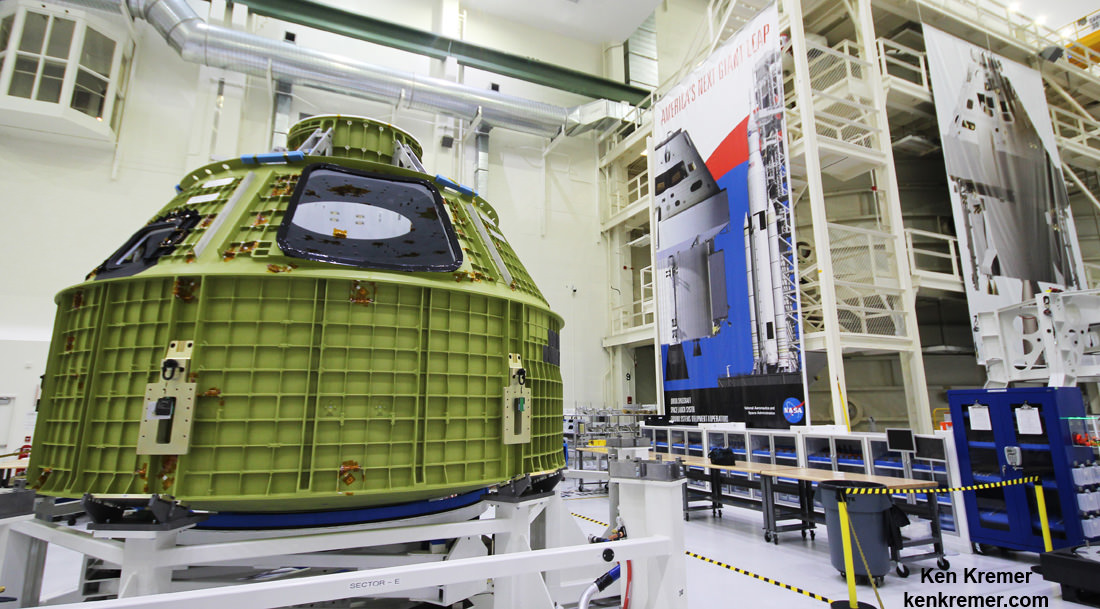
However the Trump Administration has terminated NASA’s somewhat controversial plans for the Asteroid Redirect Mission (ARM) – initiated under the Obama Administration – to robotically retrieve a near Earth asteroid and redirect it to lunar orbit for a visit by a crewed Orion to gather unique asteroidal samples.
“While we are ending formulation of a mission to an asteroid, known as the Asteroid Redirect Mission, many of the central technologies in development for that mission will continue, as they constitute vital capabilities needed for future human deep space missions.”
Key among those vital capabilities to be retained and funded going forward is Solar Electric Propulsion (SEP).
“Solar electric propulsion (SEP) for our deep space missions is moving ahead as a key lynchpin.”
The Trump Administration’s well known dislike for Earth science and disdain of climate change has manifested itself in the form of the termination of 5 current and upcoming science missions.
NASA’s FY 2018 Earth Science budget suffers a $171 million cut to $1.8 Billion.
“While we are not proposing to move forward with Orbiting Carbon Observatory-3 (OCO-3), Plankton, Aerosol, Cloud, ocean Ecosystem (PACE), Climate Absolute Radiance and Refractivity Observatory Pathfinder (CLARREO PF), and the Radiation Budget Instrument (RBI), this budget still includes significant Earth Science efforts, including 18 Earth observing missions in space as well as airborne missions.”
The DSCOVR Earth-viewing instruments will also be shut down.
NASA’s Office of Education will also be terminated completely under the proposed FY 2018 budget and the $115 million of funding excised.
“While this budget no longer supports the formal Office of Education, NASA will continue to inspire the next generation through its missions and the many ways that our work excites and encourages discovery by learners and educators. Let me tell you, we are as committed to inspiring the next generation as ever.”
Congress will now have its say and a number of Senators, including Republicans says Trumps budget is DOA.
Stay tuned here for Ken’s continuing Earth and Planetary science and human spaceflight news.
Nighttime Delta IV Blastoff Powers Military Comsat to Orbit for U.S. Allies: Photo/Video Gallery
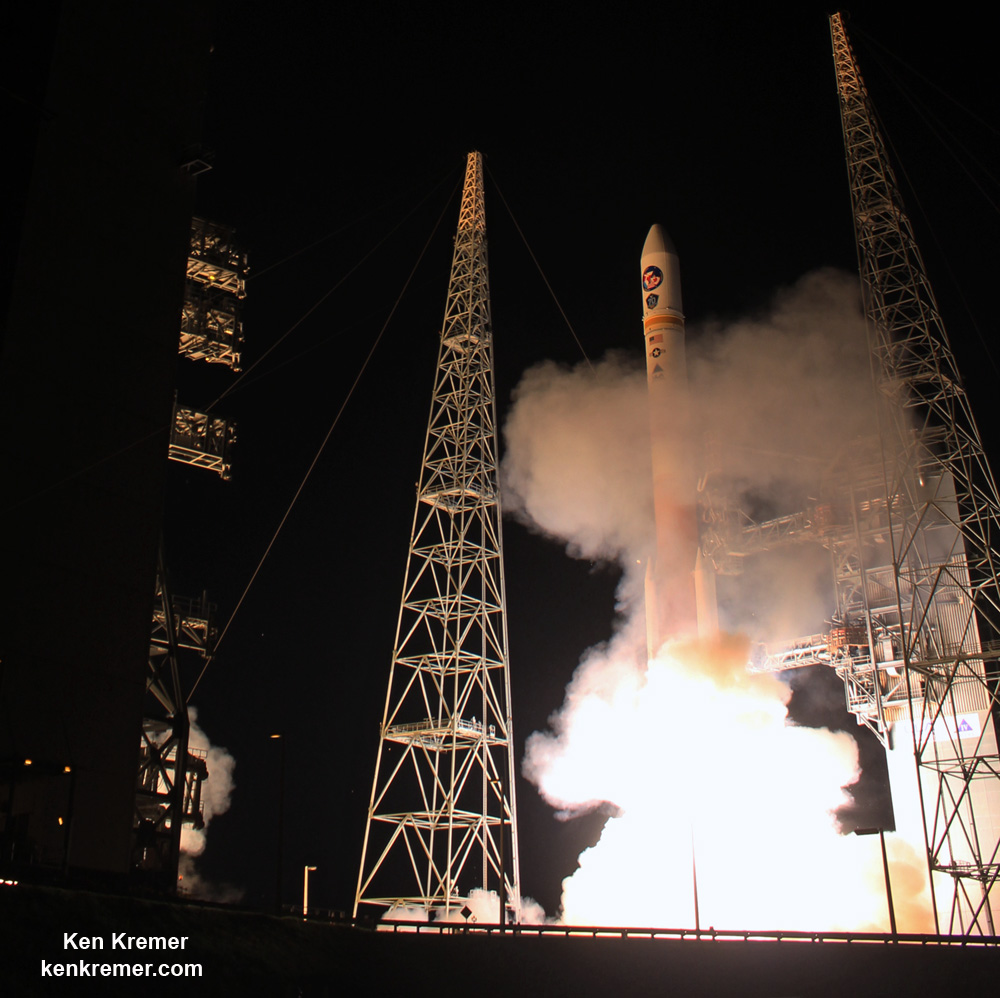

CAPE CANAVERAL AIR FORCE STATION, FL – The second round of March Launch Madness continued with the thunderous nighttime blastoff of a ULA Delta IV rocket powering a super swift military communications satellite to orbit in a collaborative effort of U.S. Allies from North America, Europe and Asia and the U.S. Air Force.
The next generation Wideband Global SATCOM-9 (WGS-9) military comsat mission for the U.S. Force lifted off atop a United Launch Alliance (ULA) Delta IV from Space Launch Complex-37 (SLC-37) on Saturday, March 18 at 8:18 p.m. EDT at Cape Canaveral Air Force Station, Florida.
Check out this expanding gallery of spectacular launch photos and videos gathered from my space journalist colleagues, myself and spectators ringing the space coast under crystal clear early evening skies.
A key feature in this advanced Block II series WGS satellite is inclusion of the upgraded digital channelizer that nearly doubles the available bandwidth of earlier satellites in the series.
WGS-9 can filter and downlink up to 8.088 GHz of bandwidth compared to 4.410 GHz for earlier WGS satellites. It supports communications links in the X-band and Ka-band spectra.

Note that Round 3 of March Launch Madness is tentatively slated for March 29 with the SpaceX liftoff of the first ever reused Falcon 9 first stage from historic pad 39 on NASA’s Kennedy Space Center.
The WGS-9 satellite was paid for by a six nation consortium that includes Canada, Denmark, Luxembourg, the Netherlands, New Zealand and the United States. It joins 8 earlier WGS satellites already in orbit.
The partnership was created back in 2012 when the ‘WGS-9 Memorandum of Understanding (MOU)’ was signed by Defense organizations of the six countries.
The WGS-9 MOU agreement to fund the satellite enabled the expansion of the WGS system with this additional satellite added to the existing WGS constellation.
“The agreement provides all signatories with assured access to global wideband satellite communications for military use,” according to the US Air Force.
Watch this launch video compilation from Jeff Seibert:
Video Caption: Launch of WGS-9 satellite continues USAF Breaking Barriers heritage. This ULA Delta 4 launch of the WGS-9 satellite on Mar 18, 2017 marks the start of the 70th anniversary of the United States Air Force. That was also the year that U.S. Air Force Captain Chuck Yeager broke the sound barrier. Credit: Jeff Seibert
Watch this launch video from Ken Kremer:
Video Caption: ULA/USAF Delta IV launch of Wideband Global SATCOM (WGS-9) from pad 37 on Cape Canaveral Air Force Station, Fl, on 18 Mar. 2017 – as seen in this remote video taken at the pad. Credit: Ken Kremer/kenkremer.com
WGS-9 was built by Boeing.
The 217 foot tall Delta IV Medium+ rocket launched in the 5,4 configuration with a 5 meter diameter payload fairing that stands 47 feet tall, and 4 solid rocket boosters to augment the first stage thrust of the single common core booster.
The payload fairing was emblazoned with decals commemorating the 70th anniversary of the USAF, as well as Air Force, mission and ULA logos.
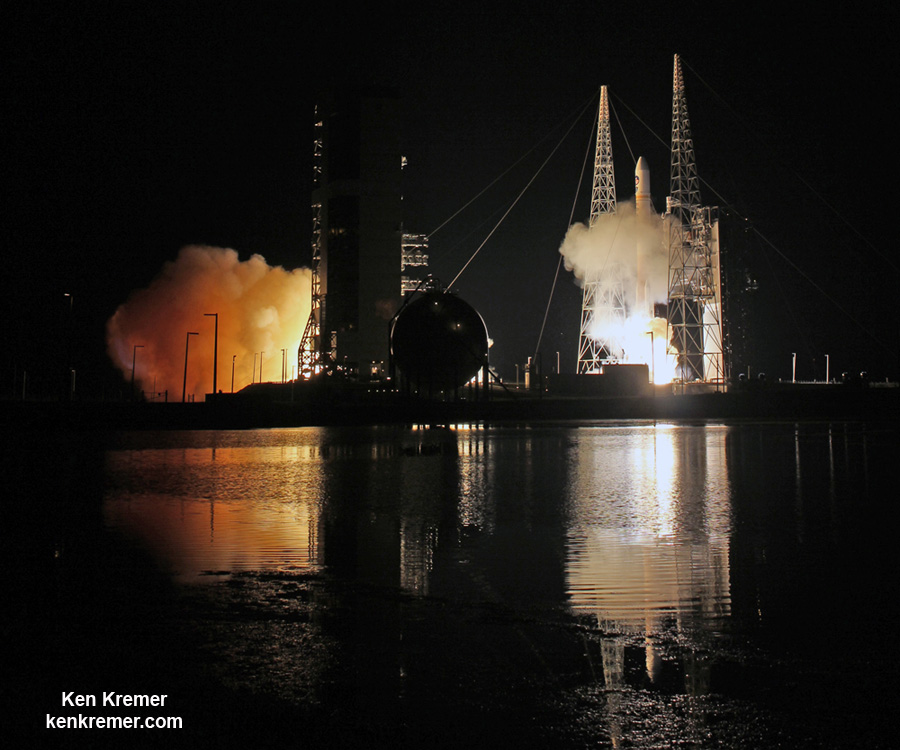
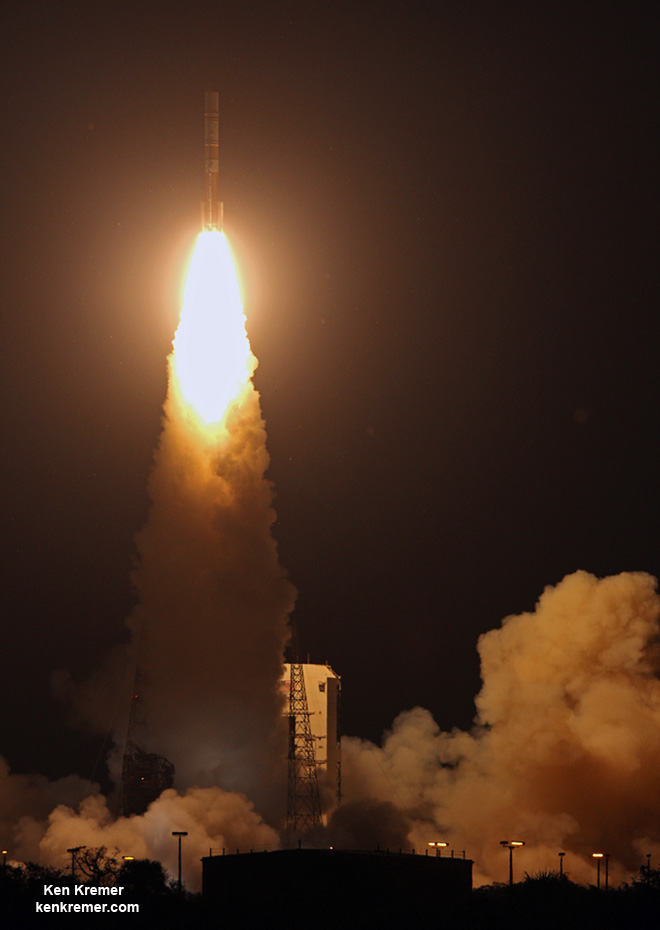
Orbital ATK manufactures the four solid rocket motors. The Delta IV common booster core was powered by an RS-68A liquid hydrogen/liquid oxygen engine producing 705,250 pounds of thrust at sea level.
A single RL10B-2 liquid hydrogen/liquid oxygen engine powered the second stage, known as the Delta Cryogenic Second Stage (DCSS).
The booster and upper stage engines are both built by Aerojet Rocketdyne. ULA constructed the Delta IV Medium+ (5,4) launch vehicle in Decatur, Alabama.
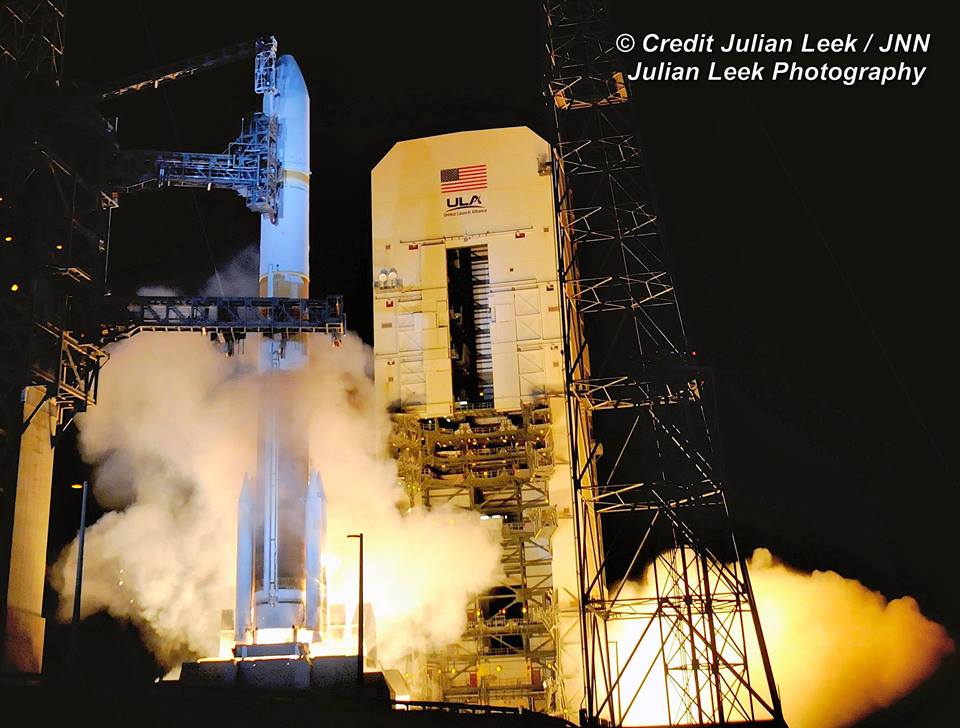
The DCSS will also serve as the upper stage for the maiden launch of NASA heavy lift SLS booster on the SLS-1 launch slated for late 2018. That DCSS/SLS-1 upper stage just arrived at the Cape last week – as I witnessed and reported here.
Saturday’s launch marks ULA’s 3rd launch in 2017 and the 118th successful launch since the company was formed in December 2006 as a joint venture between Boeing and Lockheed Martin.
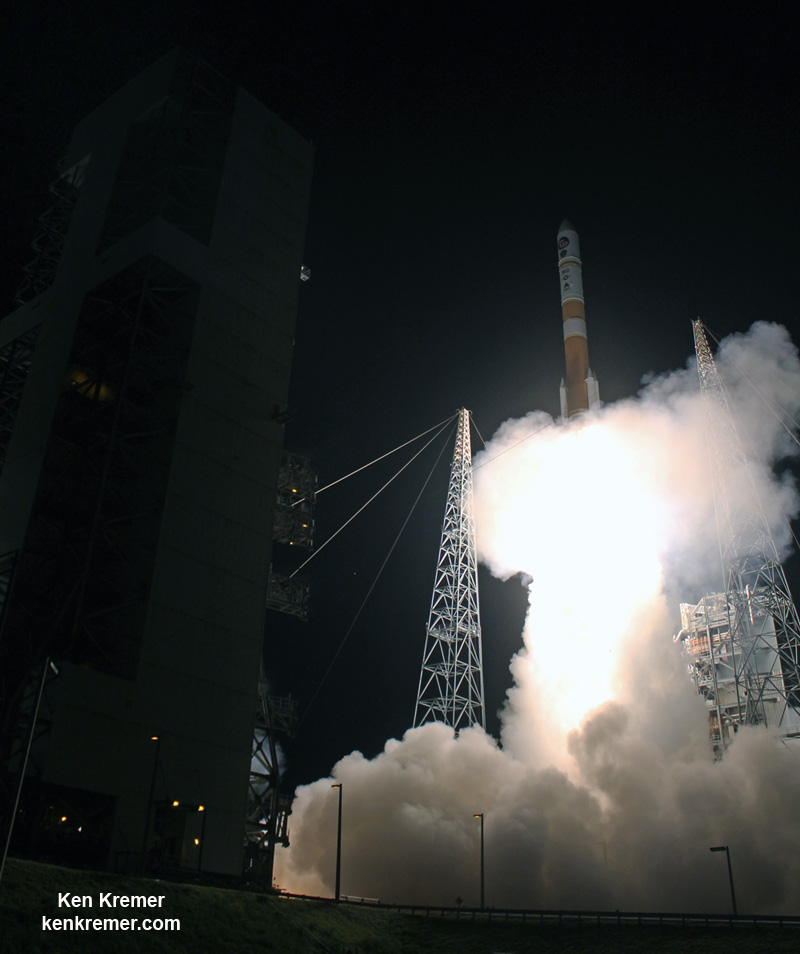
Stay tuned here for Ken’s continuing Earth and planetary science and human spaceflight news.

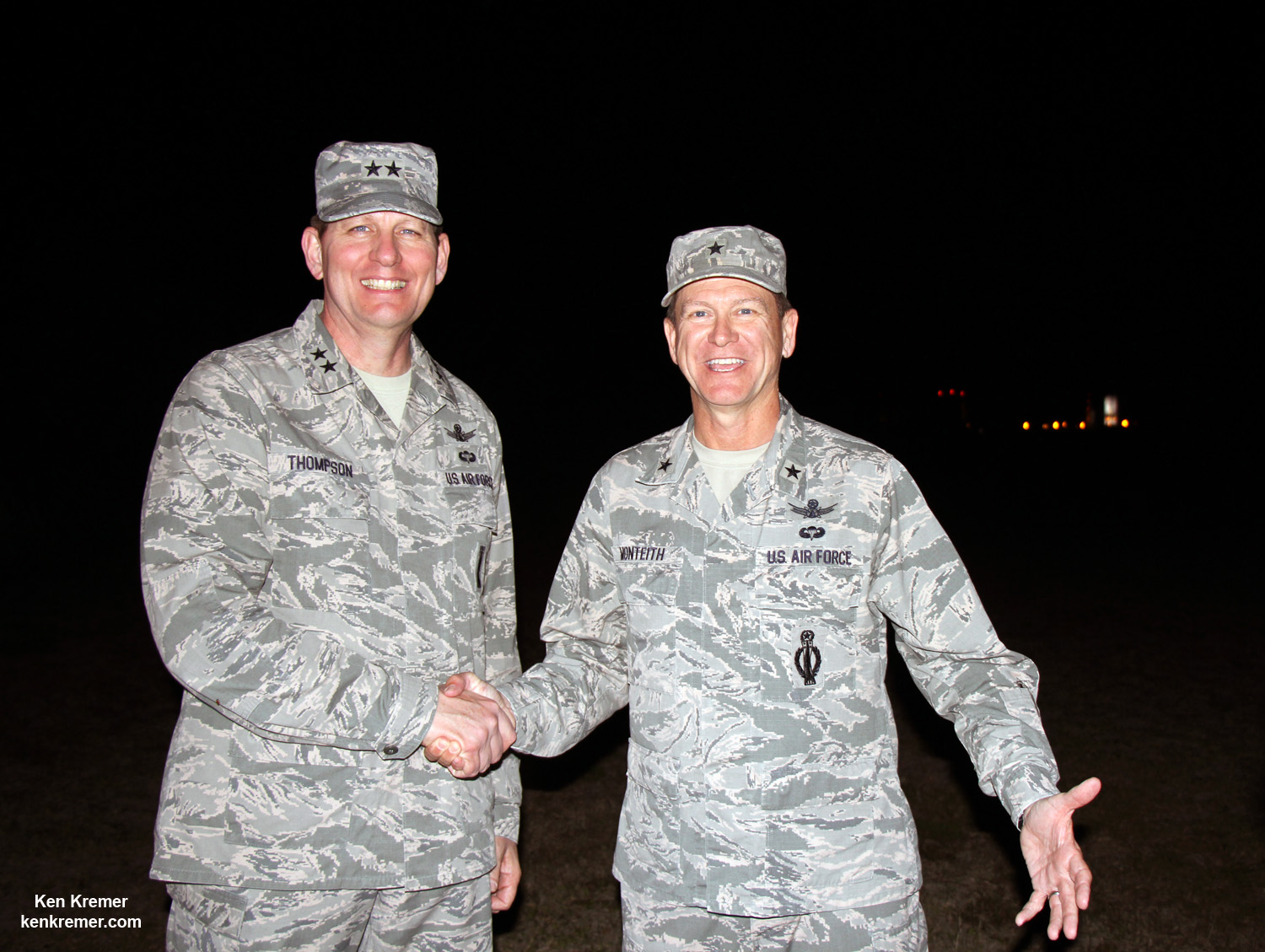


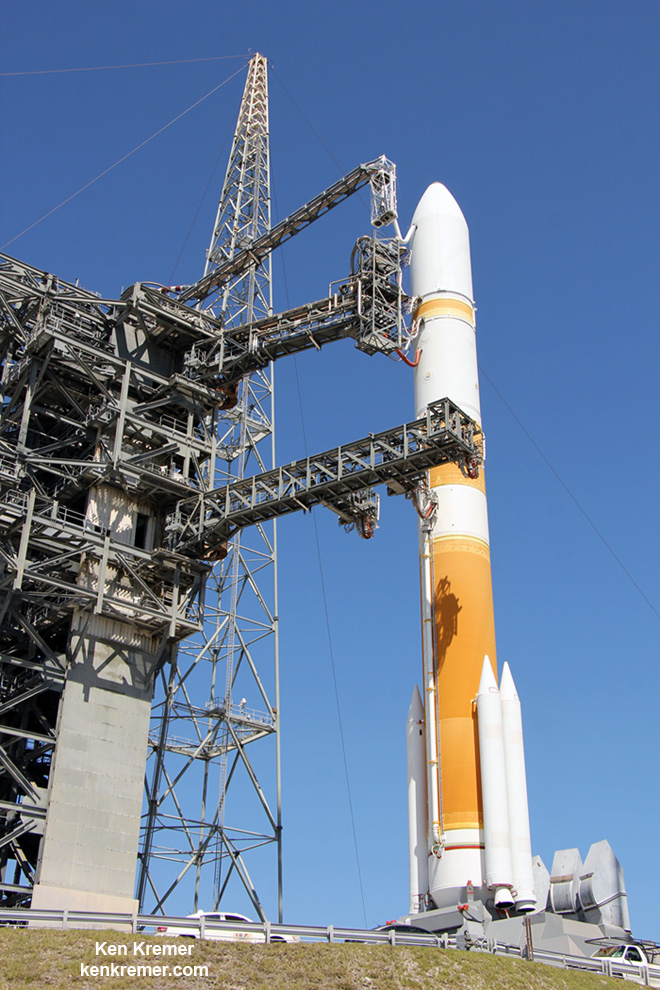
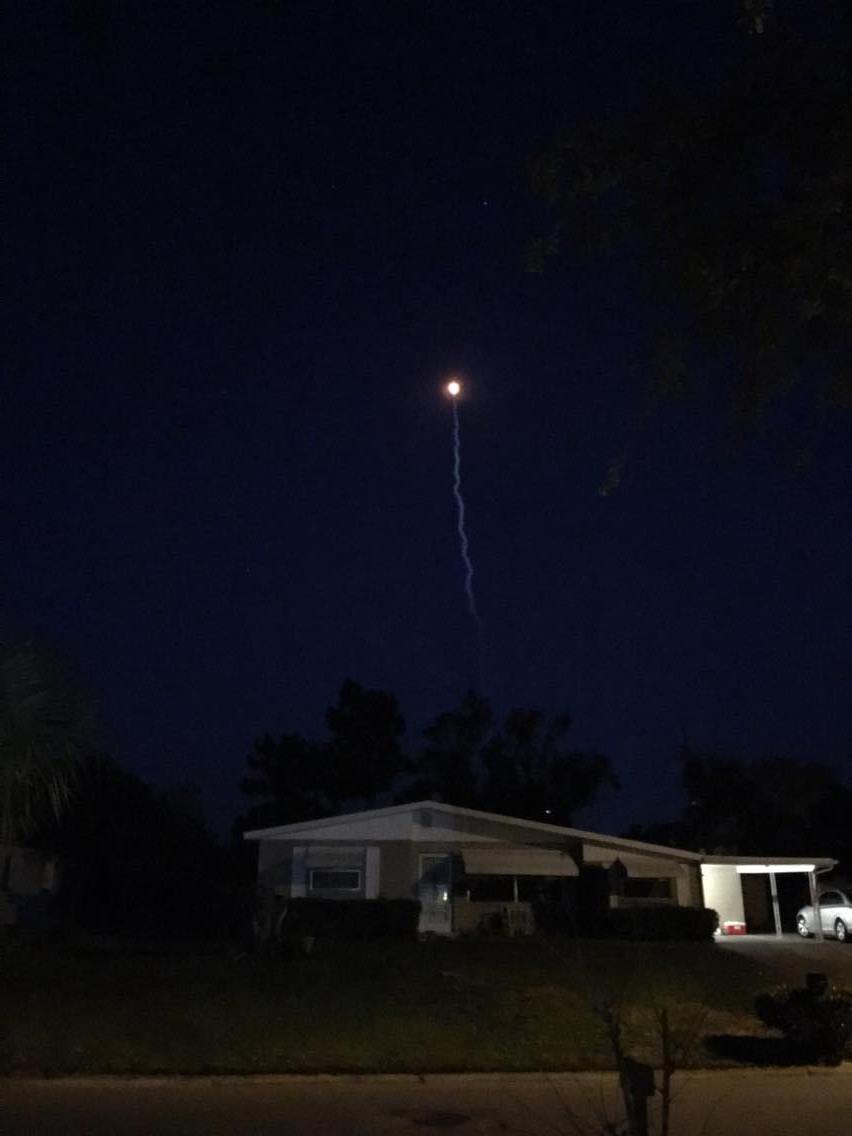
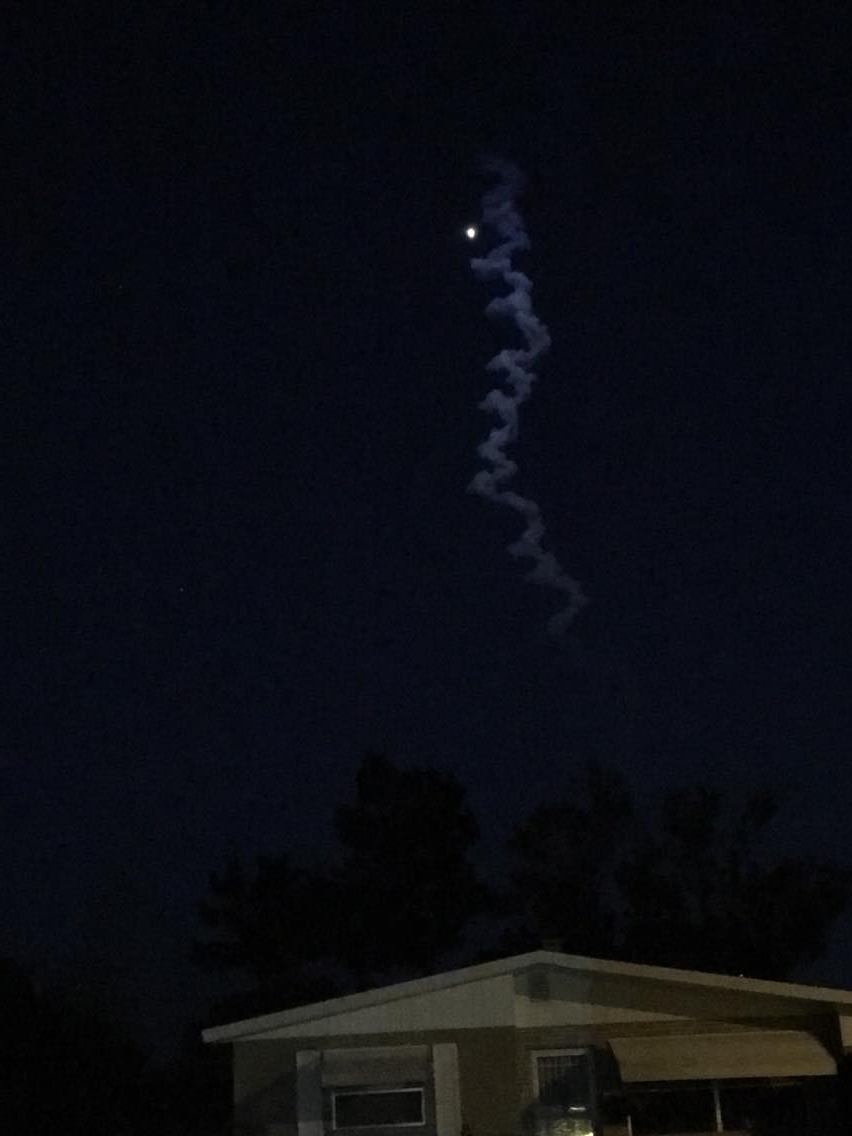
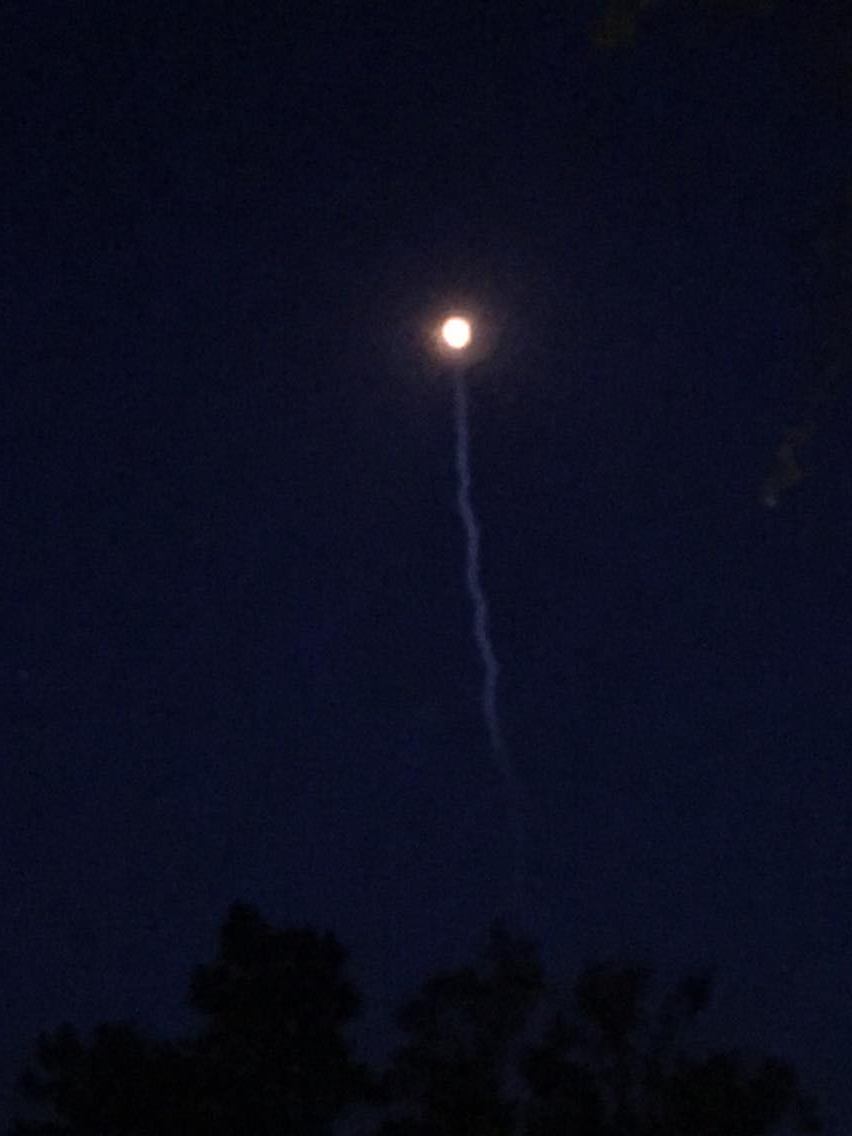
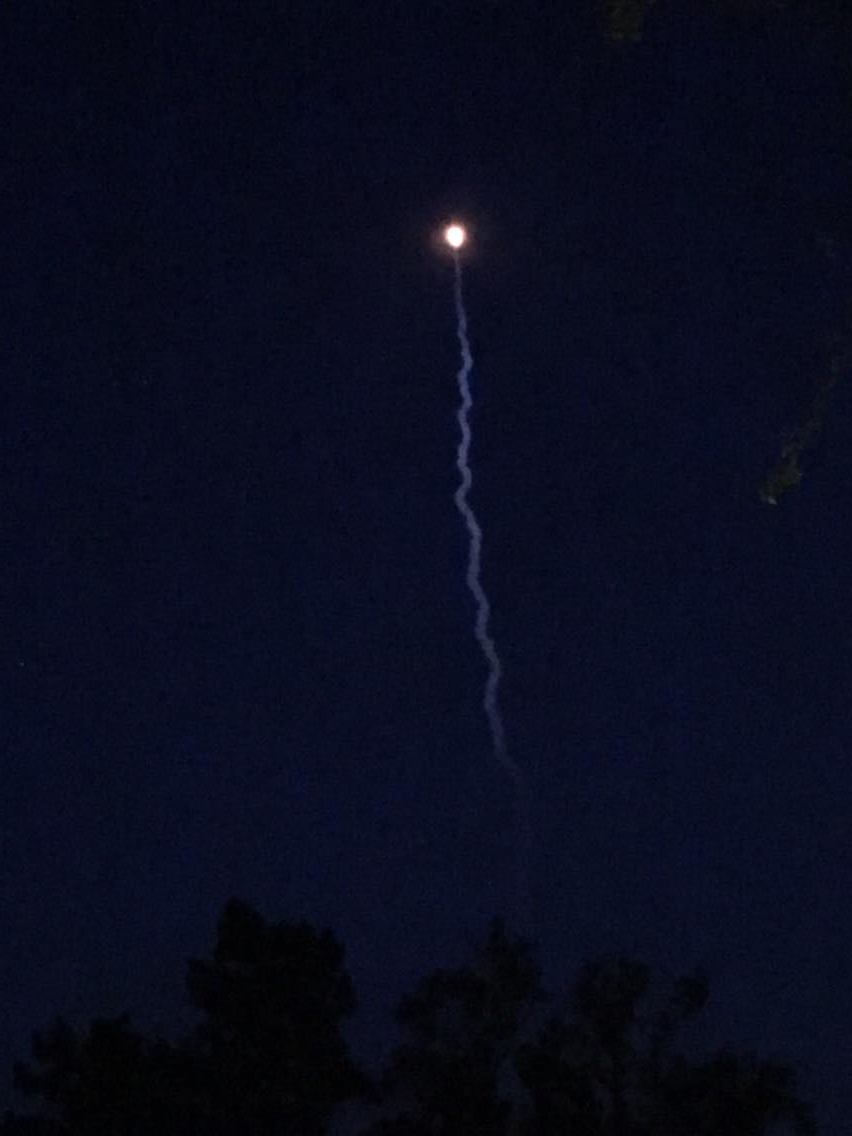
1st SLS 2nd Stage Arrives at Cape for NASA’s Orion Megarocket Moon Launch in 2018
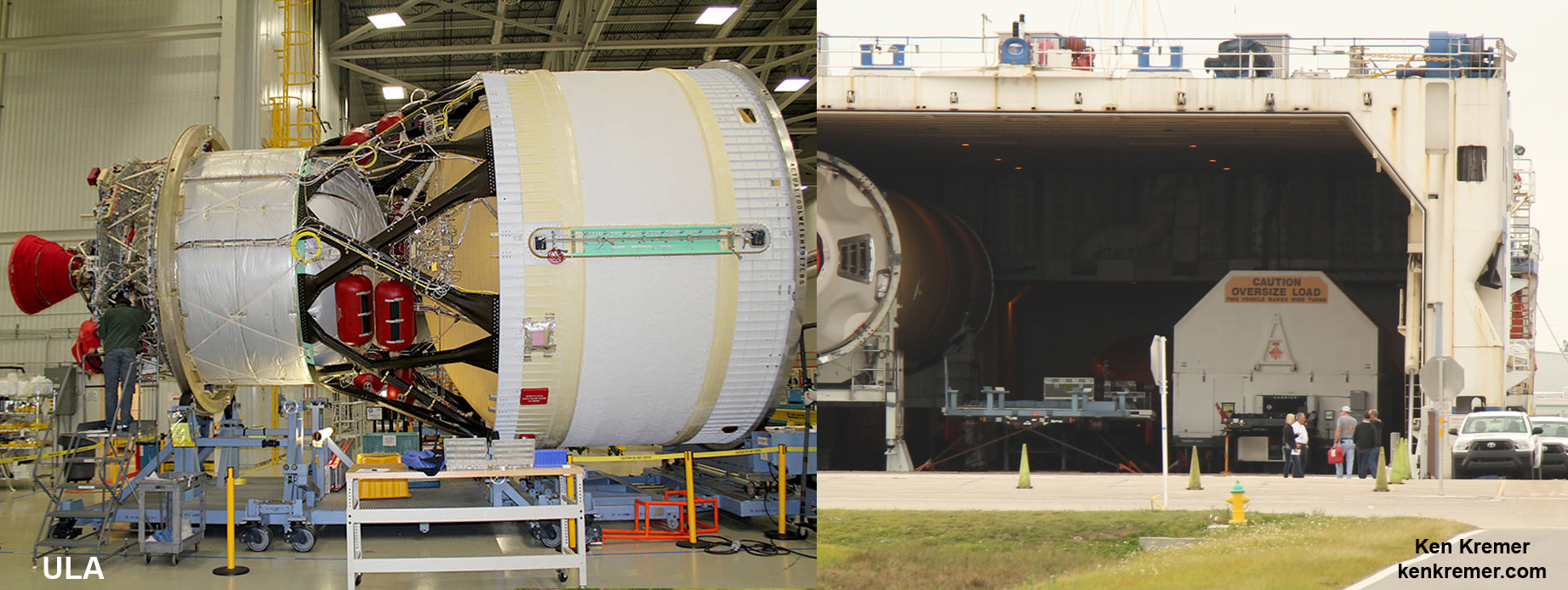

PORT CANAVERAL – Bit by bit, piece by piece, the first of NASA’s SLS megarockets designed to propel American astronauts on deep space missions back to the Moon and beyond to Mars is at last coming together on the Florida Space Coast. And the first big integrated piece of actual flight hardware – the powerful second stage named the Interim Cryogenic Propulsion Stage (ICPS) – has just arrived by way of barge today (Mar. 7) at Port Canaveral, Fl.
The ICPS will propel NASA’s new Orion crew capsule on its maiden uncrewed mission around the Moon – currently slated for blastoff on the inaugural SLS monster rocket on the Exploration Mission-1 (EM-1) mission late next year.
SLS-1/Orion EM-1 will launch from pad 39B at NASA’s Kennedy Space Center in late 2018. The SLS will be the most powerful rocket in world history.
NASA is currently evaluating whether to add a crew of 2 astronauts to the SLS-1 launch which would result in postponing the inaugural liftoff into 2019 – as I reported here.
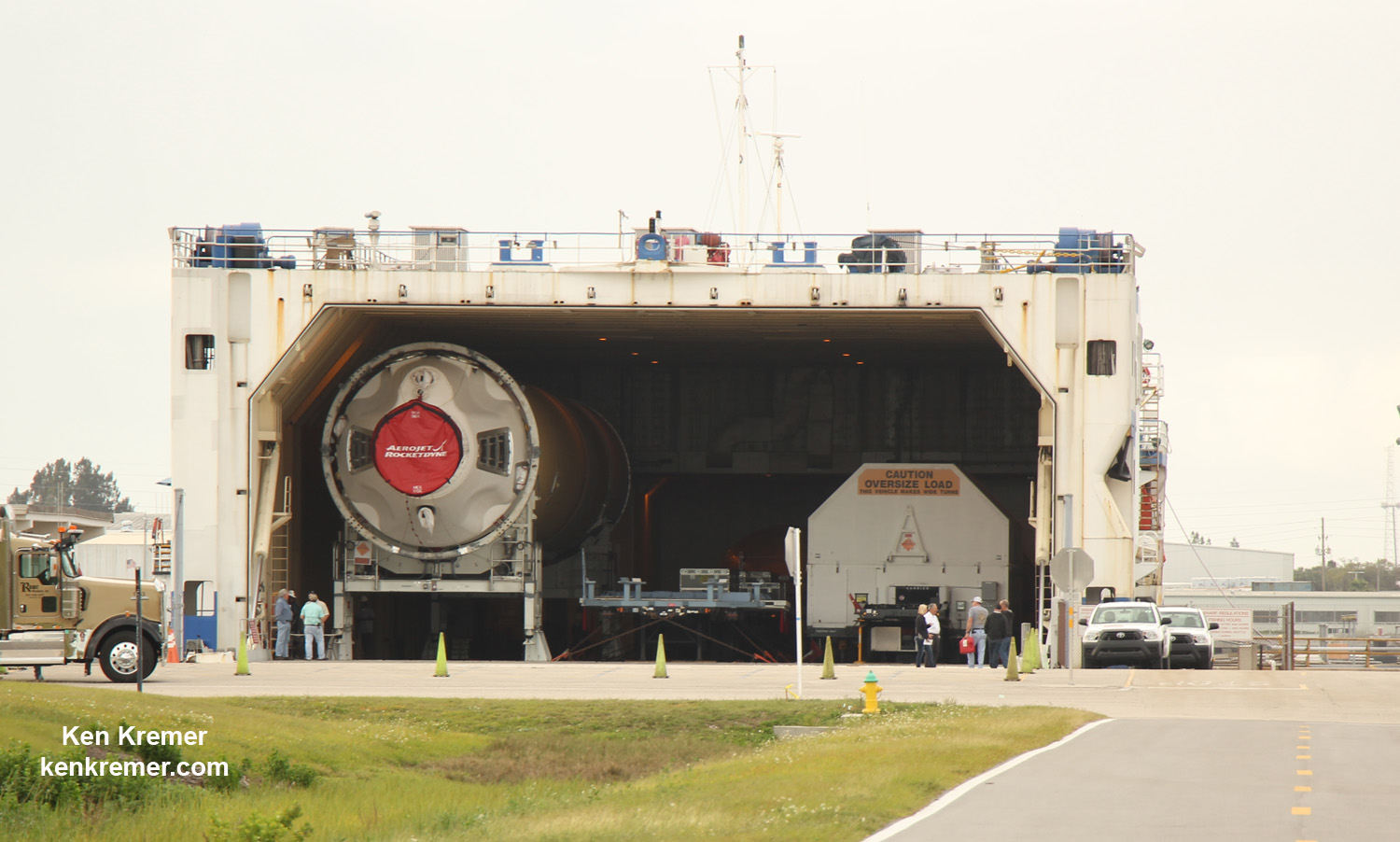
The SLS upper stage – designed and built by United Launch Alliance (ULA) and Boeing – arrived safely by way of the specially-designed ship called the Delta Mariner early Tuesday morning, Mar. 7, into the channel of Port Canaveral, Florida – as witnessed by this author.
“We are proud to be working with The Boeing Company and NASA to further deep space exploration!” ULA said in a statement.
Major assembly of the ICPS was completed at ULA’s Decatur, Alabama, manufacturing facility in December 2016.
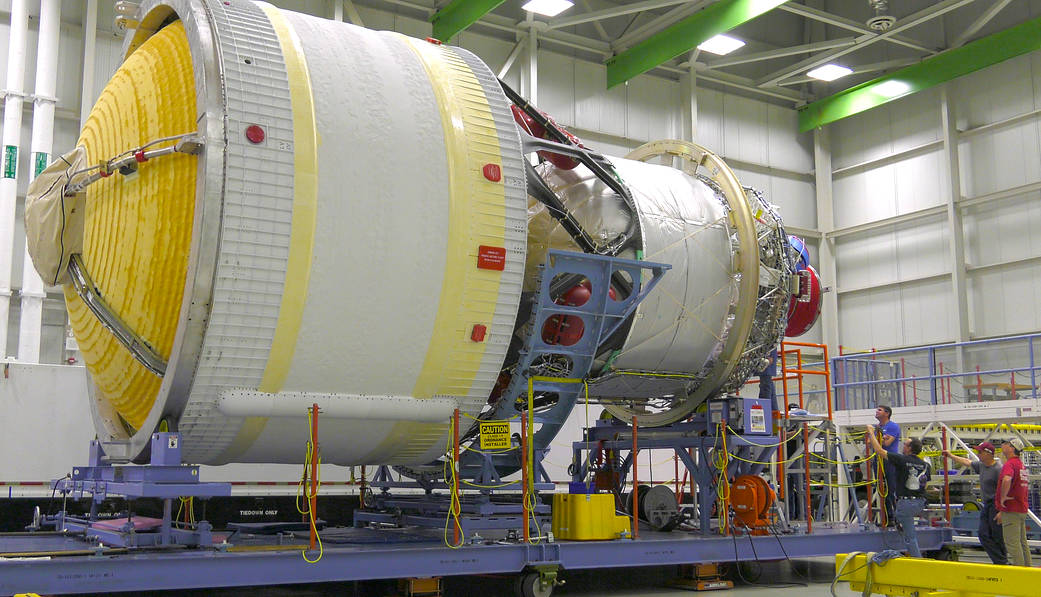
The ICPS is the designated upper stage for the first maiden launch of the initial Block 1 version of the SLS.
It is based on ULA’s Delta Cryogenic Second Stage which has successfully flown numerous times on the firm’s Delta IV family of rockets.
In the event that NASA decides to add a two person crew to the EM-1 mission, Bill Hill, NASA’s deputy associate administrator for Exploration Systems Development in Washington, D.C., stated that the agency would maintain the Interim Cryogenic Propulsion stage for the first flight, and not switch to the more advanced and powerful Exploration Upper Stage (EUS) planned for first use on the EM-2 mission.

The ICPS was loaded onto the Delta Mariner and departed Decatur last week to began its sea going voyage of more than 2,100 miles (3300 km). The barge trip normally takes 8 to 10 days.
“ULA has completed production on the interim cryogenic propulsion stage (ICPS) flight hardware for NASA’s Space Launch System and it’s on the way to Cape Canaveral aboard the Mariner,” ULA noted in a statement last week.
The 312-foot-long (95-meter-long) ULA ship docked Tuesday morning at the wharf at Port Canaveral to prepare for off loading from the roll-on, roll-off vessel.
The Delta Mariner can travel on both rivers and open seas and navigate in waters as shallow as nine feet.
“ICPS, the first integrated SLS hardware to arrive at the Cape, will provide in-space propulsion for the SLS rocket on its Exploration Mission-1 (EM-1) mission,” according to ULA.
The next step for the upper stage is ground transport to United Launch Alliance’s Delta IV Operation Center on Cape Canaveral Air Force Station in Florida for further testing and processing before being moved to the Kennedy Space Center.
ULA will deliver the ICPS to NASA in mid-2017.
“It will be the first integrated piece of SLS hardware to arrive at the Cape and undergo final processing and testing before being moved to Ground Systems Development Operations at NASA’s Kennedy Space Center,” said NASA officials.
“The ICPS is a liquid oxygen/liquid hydrogen-based system that will provide the thrust needed to send the Orion spacecraft and 13 secondary payloads beyond the moon before Orion returns to Earth.”
The upper stage is powered by a single RL-10B-2 engine fueled by liquid hydrogen and oxygen and generates 24,750 pounds of thrust. It measures 44 ft 11 in (13.7 m ) in length and 16 ft 5 in (5 m) in width.
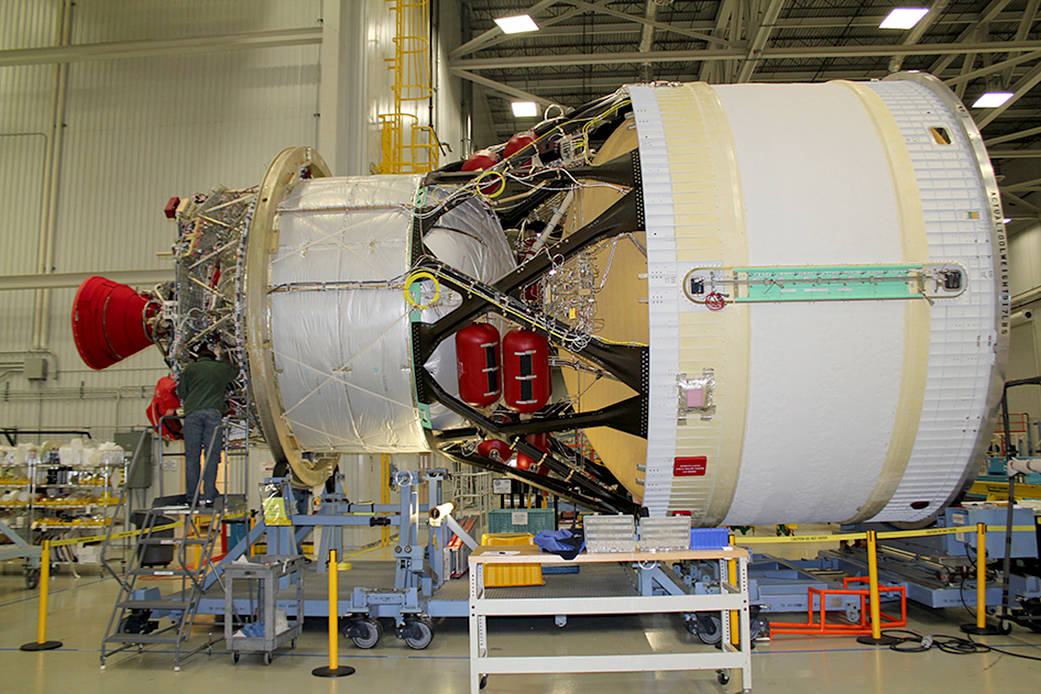
All major elements of the SLS will be assembled for flight inside the high bay of NASA’s iconic Vehicle Assembly Building which is undergoing a major overhaul to accommodate the SLS. The VAB high bay was extensively refurbished to convert it from Space Shuttle to SLS assembly and launch operations.

For SLS-1 the mammoth booster will launch in its initial 70-metric-ton (77-ton) Block 1 configuration with a liftoff thrust of 8.4 million pounds – more powerful than NASA’s Saturn V moon landing rocket.
Components of the SLS-1 rocket are being manufactured at NASA’s Michoud Assembly Facility and elsewhere around the country by numerous suppliers.
Michoud is building the huge liquid oxygen/liquid hydrogen SLS core stage fuel tank, derived from the Space Shuttle External Tank (ET) – as I detailed here.
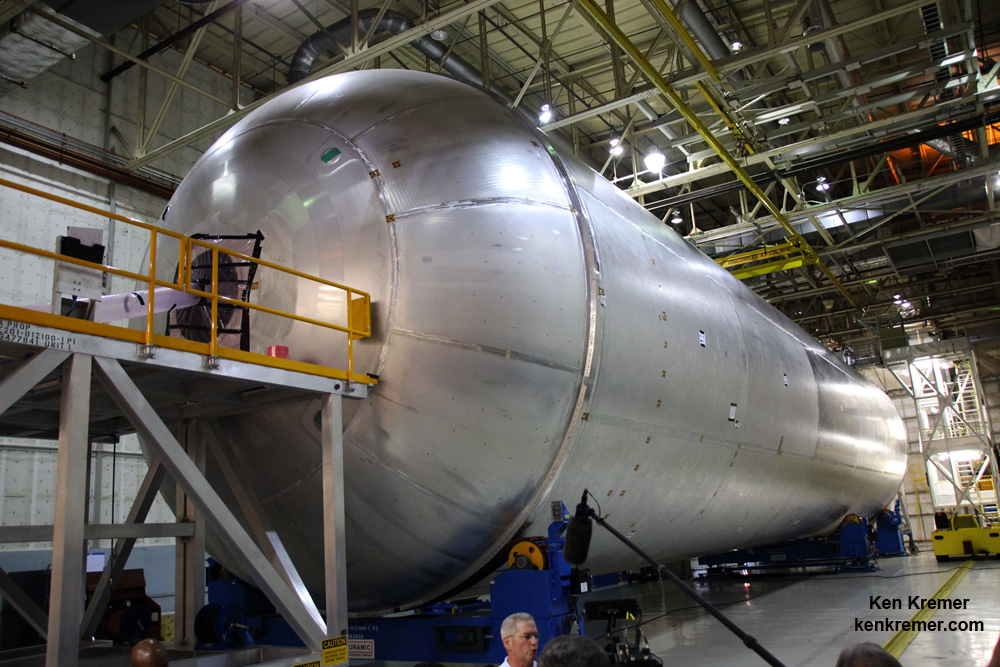
The ICPS sits on top of the SLS core stage.
The next Delta IV rocket launching with a Delta Cryogenic Second Stage is tentatively slated for March 14 from pad 37 at the Cape.
The Orion EM-1 capsule is currently being manufactured at the Neil Armstrong Operations and Checkout Building at the Kennedy Space Center by prime contractor Lockheed Martin.

Stay tuned here for Ken’s continuing Earth and Planetary science and human spaceflight news.
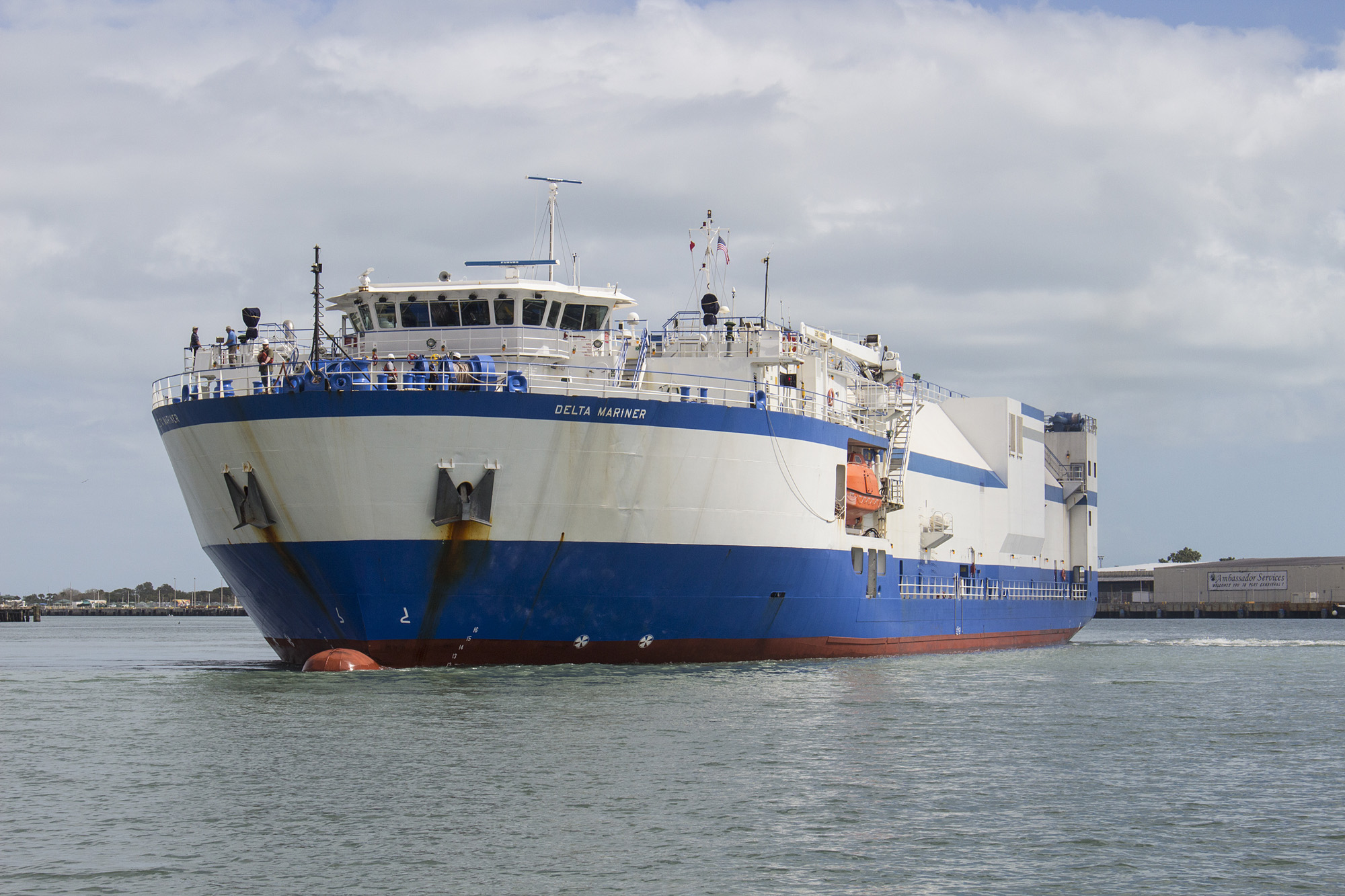
NASA Approves First Commercial Airlock for Space Station Science and SmallSat Deployment
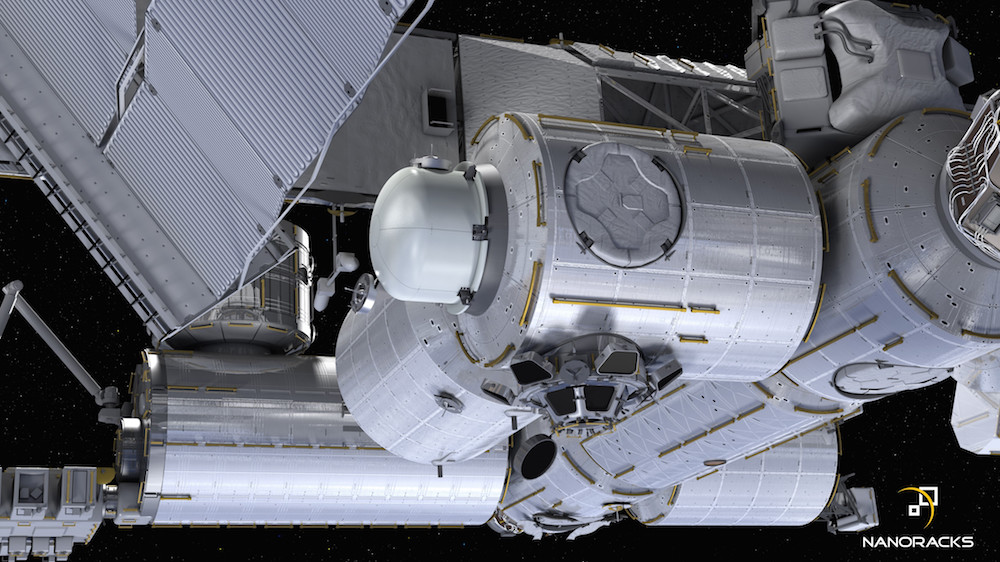

In a significant move towards further expansion of the International Space Station’s (ISS) burgeoning research and commercial space economy capabilities, NASA has approved the development of the first privately developed airlock and is targeting blastoff to the orbiting lab complex in two years.
Plans call for the commercial airlock to be launched on a commercial cargo vessel and installed on the U.S. segment of the ISS in 2019.
It enhances the US capability to place equipment and payloads outside and should triple the number of small satellites like CubeSats able to be deployed.
The privately funded commercial airlock is being developed by Nanoracks in partnership with Boeing, which is the prime contractor for the space station.
The airlock will be installed on an open port on the Tranquility module – that already is home to the seven windowed domed Cupola observation deck and the commercial BEAM expandable module built by Bigelow Aerospace.
“We want to utilize the space station to expose the commercial sector to new and novel uses of space, ultimately creating a new economy in low-Earth orbit for scientific research, technology development and human and cargo transportation,” said Sam Scimemi, director, ISS Division at NASA Headquarters in Washington, in a statement.
“We hope this new airlock will allow a diverse community to experiment and develop opportunities in space for the commercial sector.”
The airlock will launch aboard one of NASA’s commercial cargo suppliers in 2019. But the agency has not specified which contractor. The candidates include the SpaceX cargo Dragon, an enhanced ATK Cygnus or potentially the yet to fly SNC Dream Chaser.
Boeing will supply the airlock’s Passive Common Berthing Mechanism (CBM) hardware to connect it to the Tranquility module.
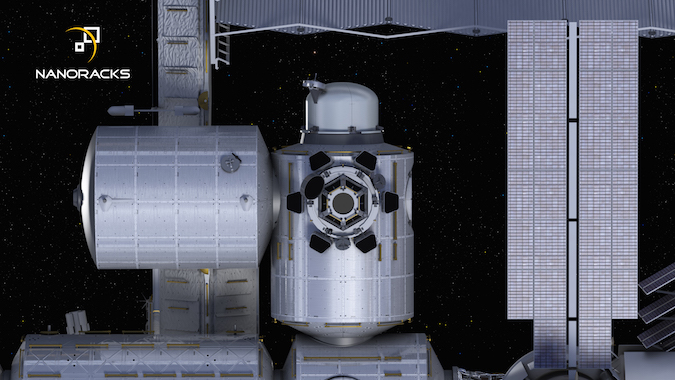
The airlock will beef up the capability of transferring equipment, payloads and deployable satellites from inside the ISS to outside, significantly increasing the utilization of ISS, says Boeing.
“The International Space Station allows NASA to conduct cutting-edge research and technology demonstrations for the next giant leap in human exploration and supports an emerging space economy in low-Earth orbit. Deployment of CubeSats and other small satellite payloads from the orbiting laboratory by commercial customers and NASA has increased in recent years. To support demand, NASA has accepted a proposal from NanoRacks to develop the first commercially funded airlock on the space station,” says NASA.
“The installation of NanoRacks’ commercial airlock will help us keep up with demand,” said Boeing International Space Station program manager Mark Mulqueen. “This is a big step in facilitating commercial business on the ISS.”
Right now the US uses the airlock on the Japanese Experiment Module (JEM) to place payloads on the stations exterior as well as for small satellite deployments. But the demand is outstripping the JEM’s availability.
The Nanoracks airlock will be larger and more robust to take up the slack.
NASA has stipulated that the Center for the Advancement of Science in Space (CASIS), NASA’s manager of the U.S. National Laboratory on the space station, will be responsible for coordinating all payload deployments from the commercial airlock – NASA and non NASA.
“We are entering a new chapter in the space station program where the private sector is taking on more responsibilities. We see this as only the beginning and are delighted to team with our friends at Boeing,” said Jeffrey Manber, CEO of NanoRacks.
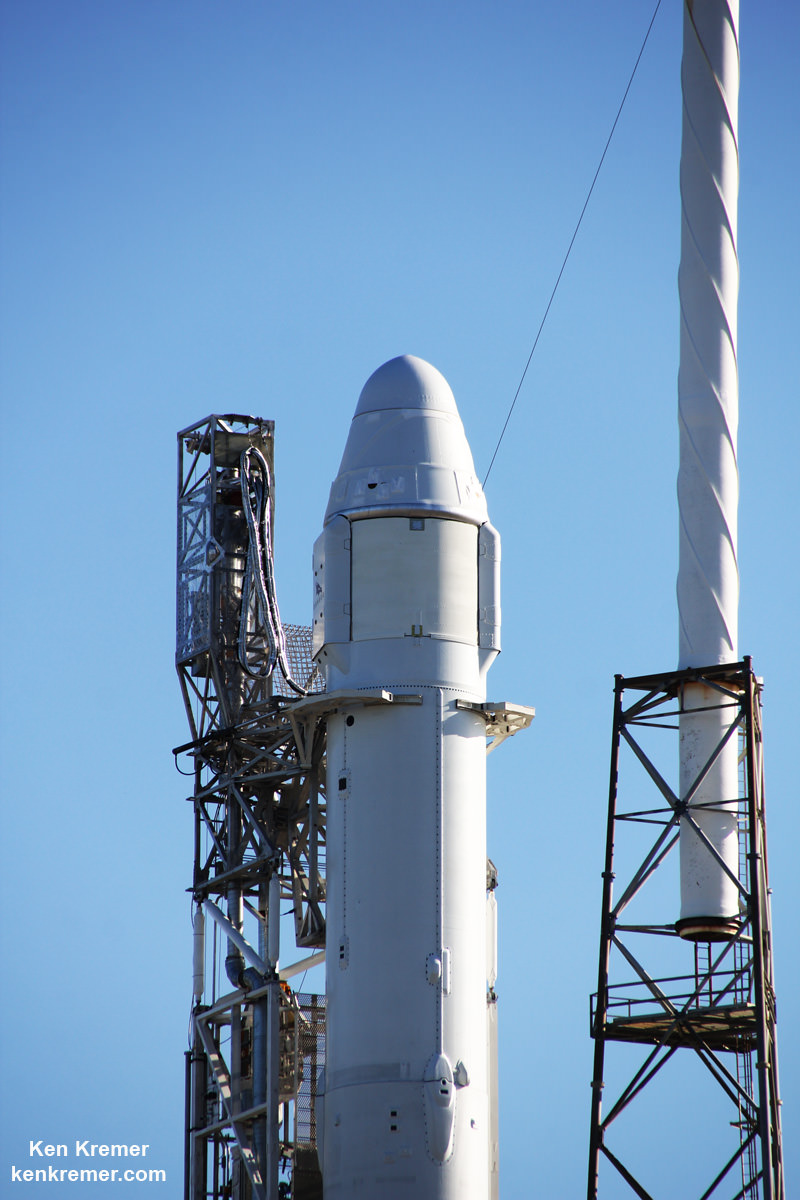
Stay tuned here for Ken’s continuing Earth and Planetary science and human spaceflight news.

